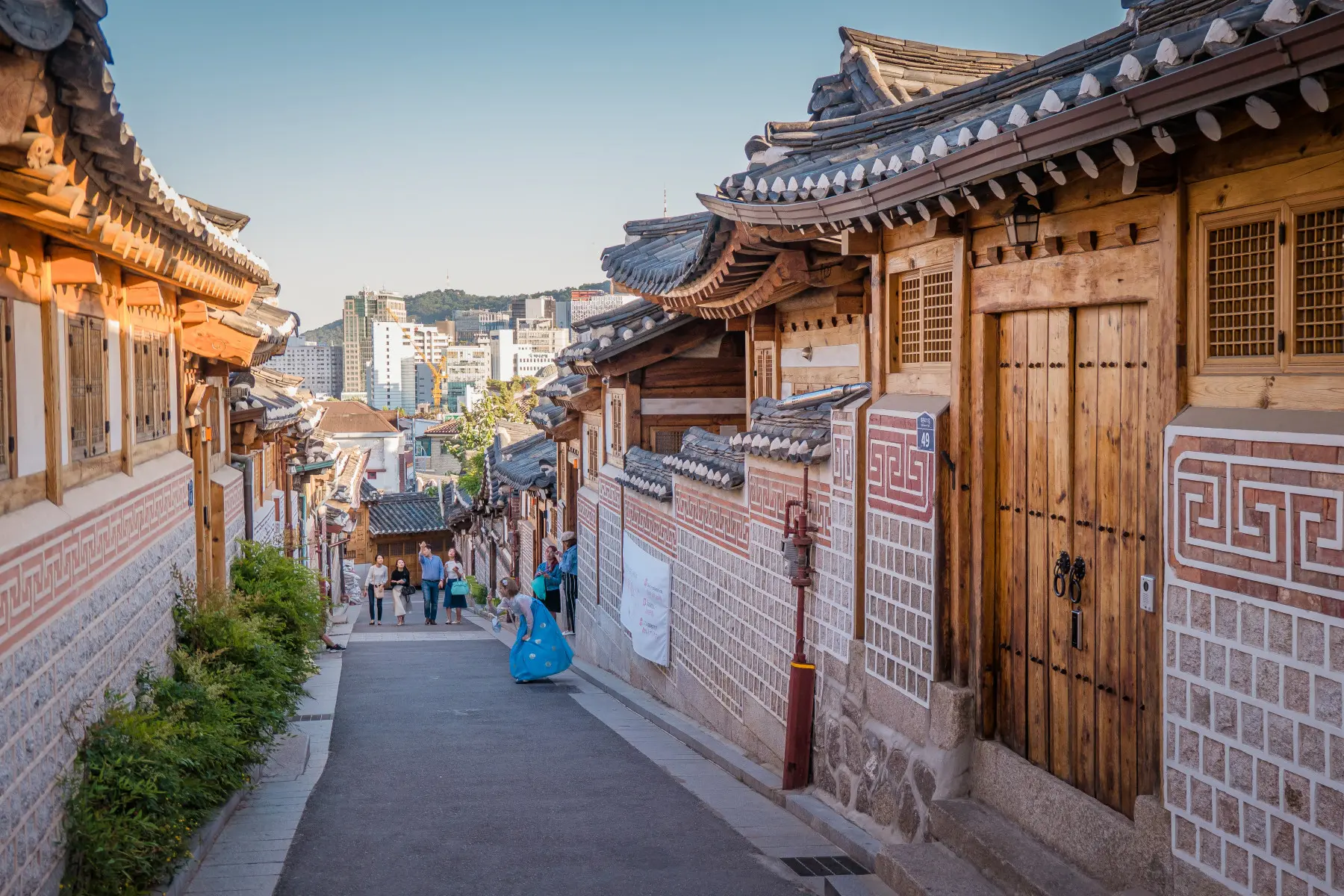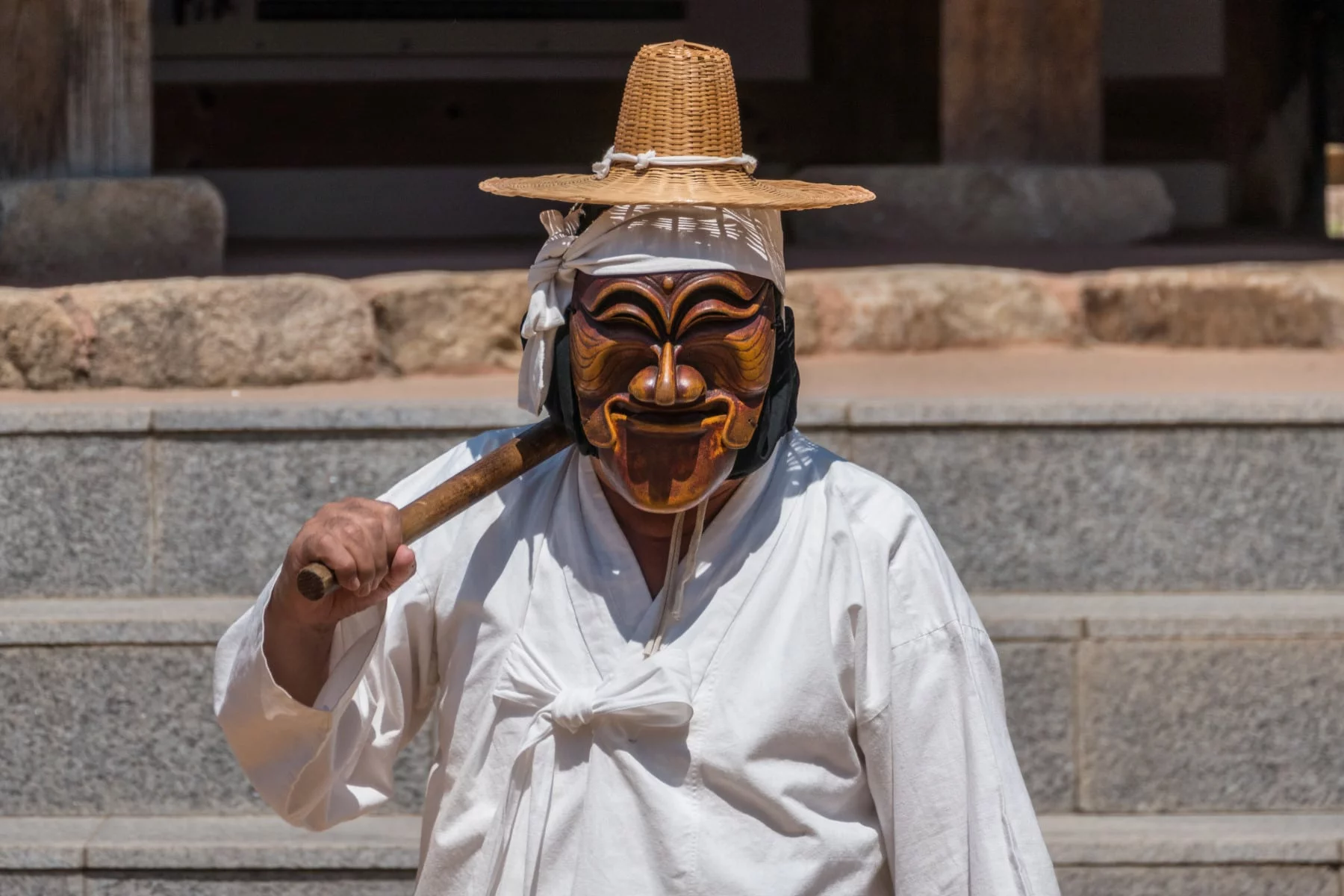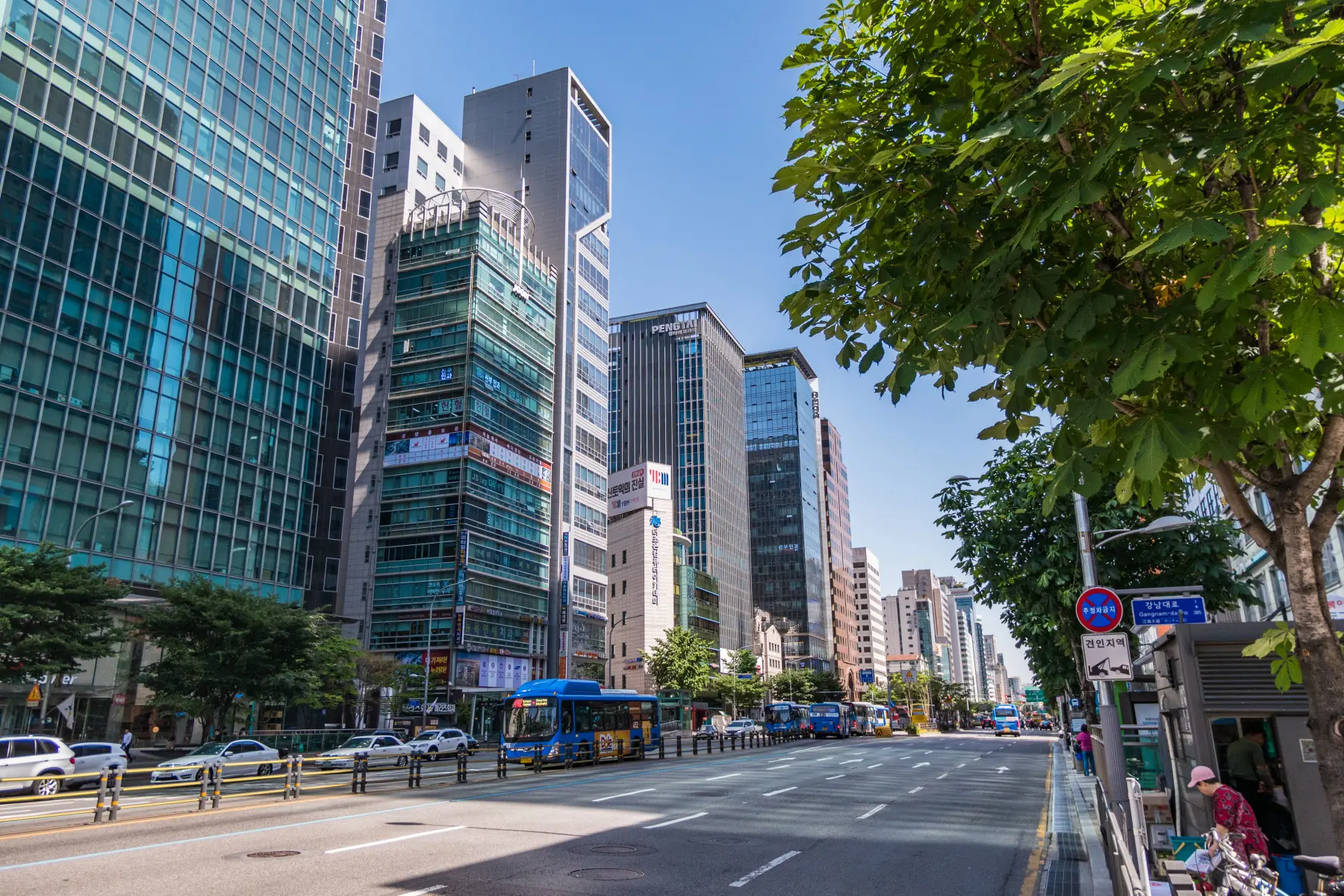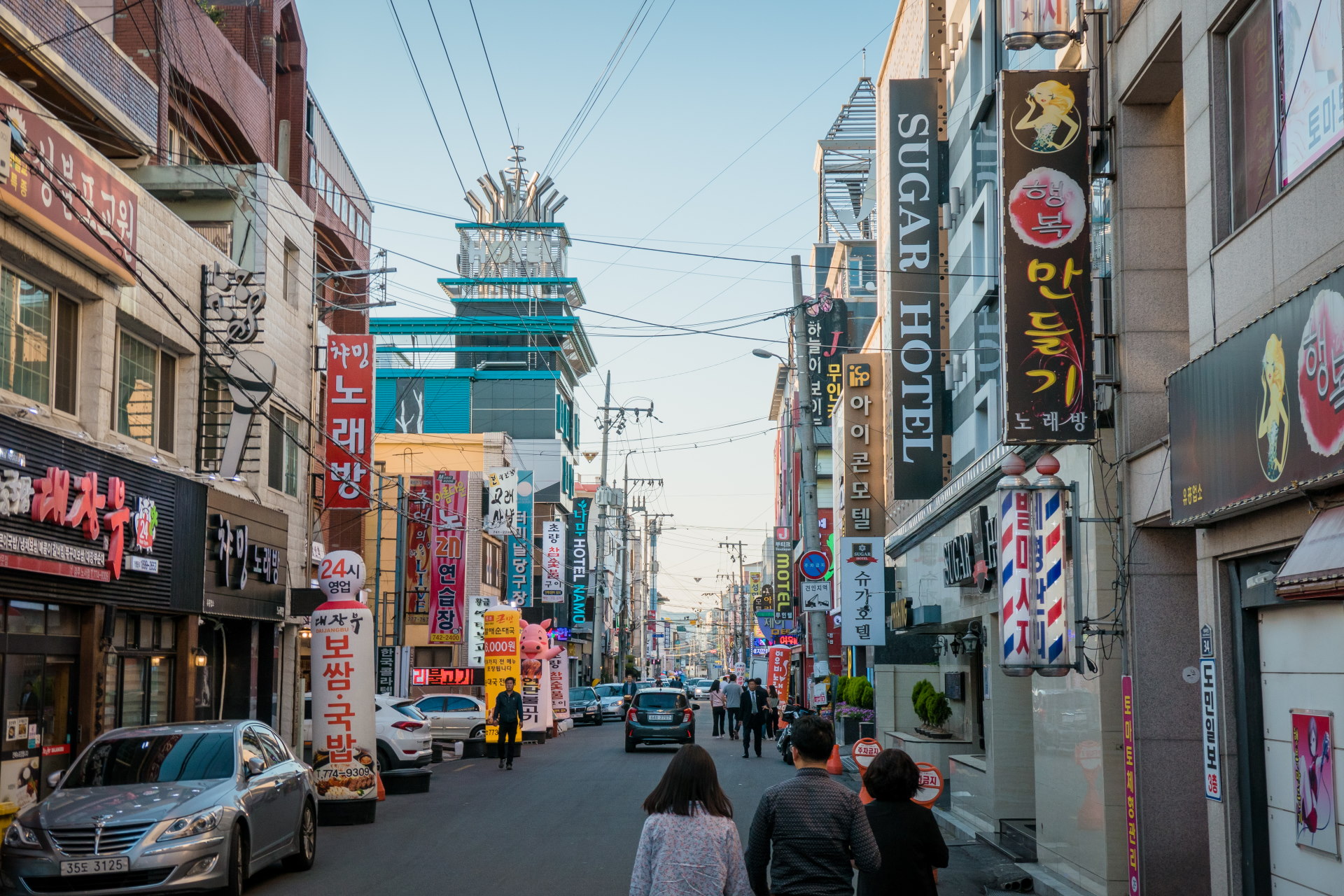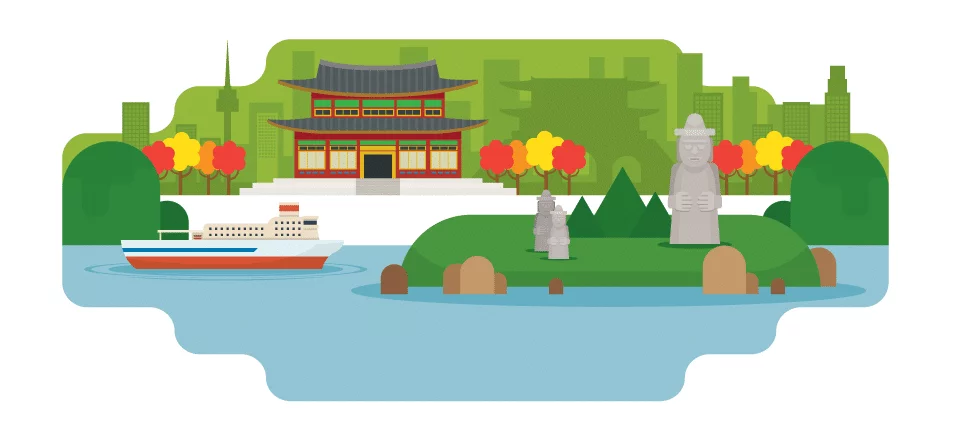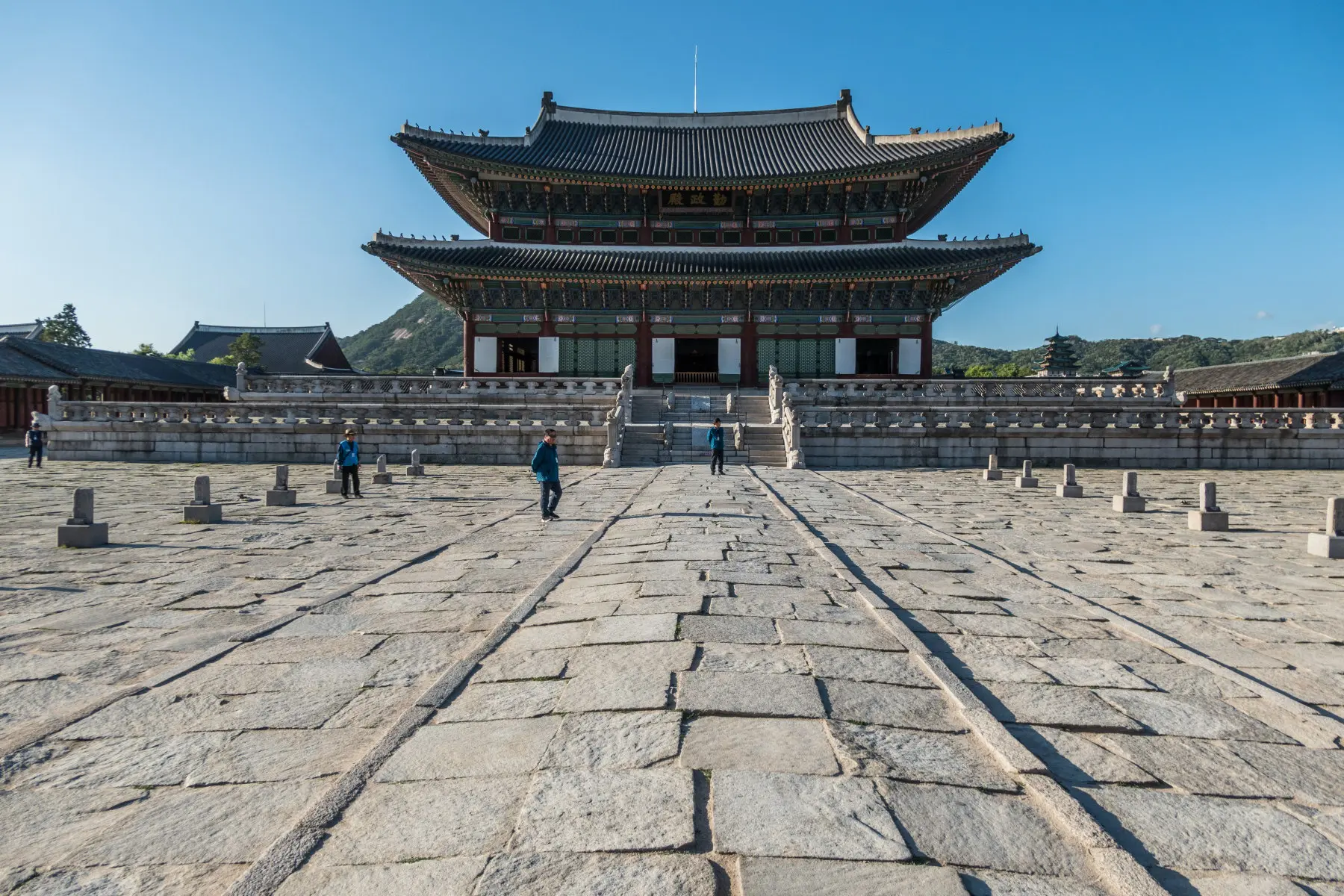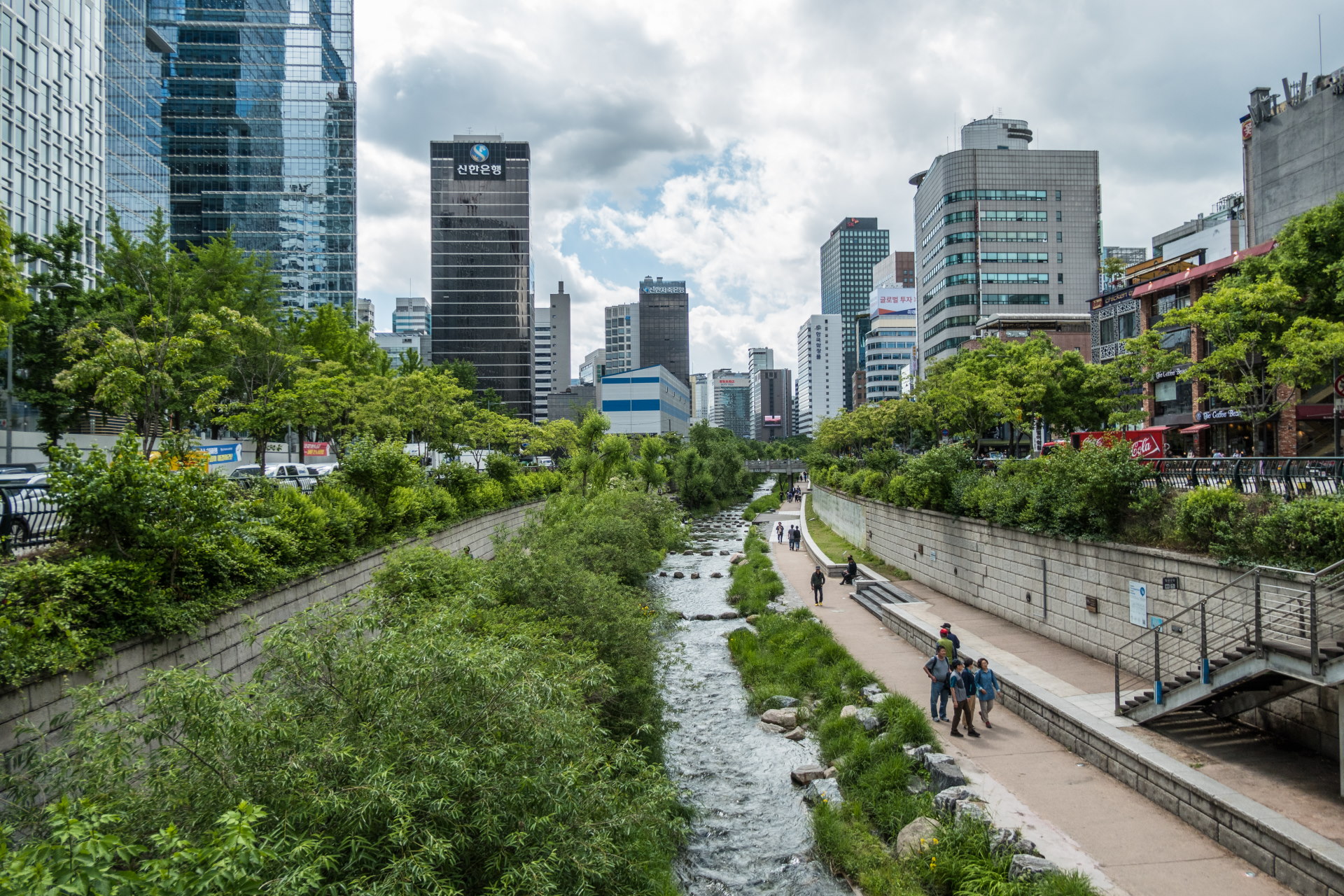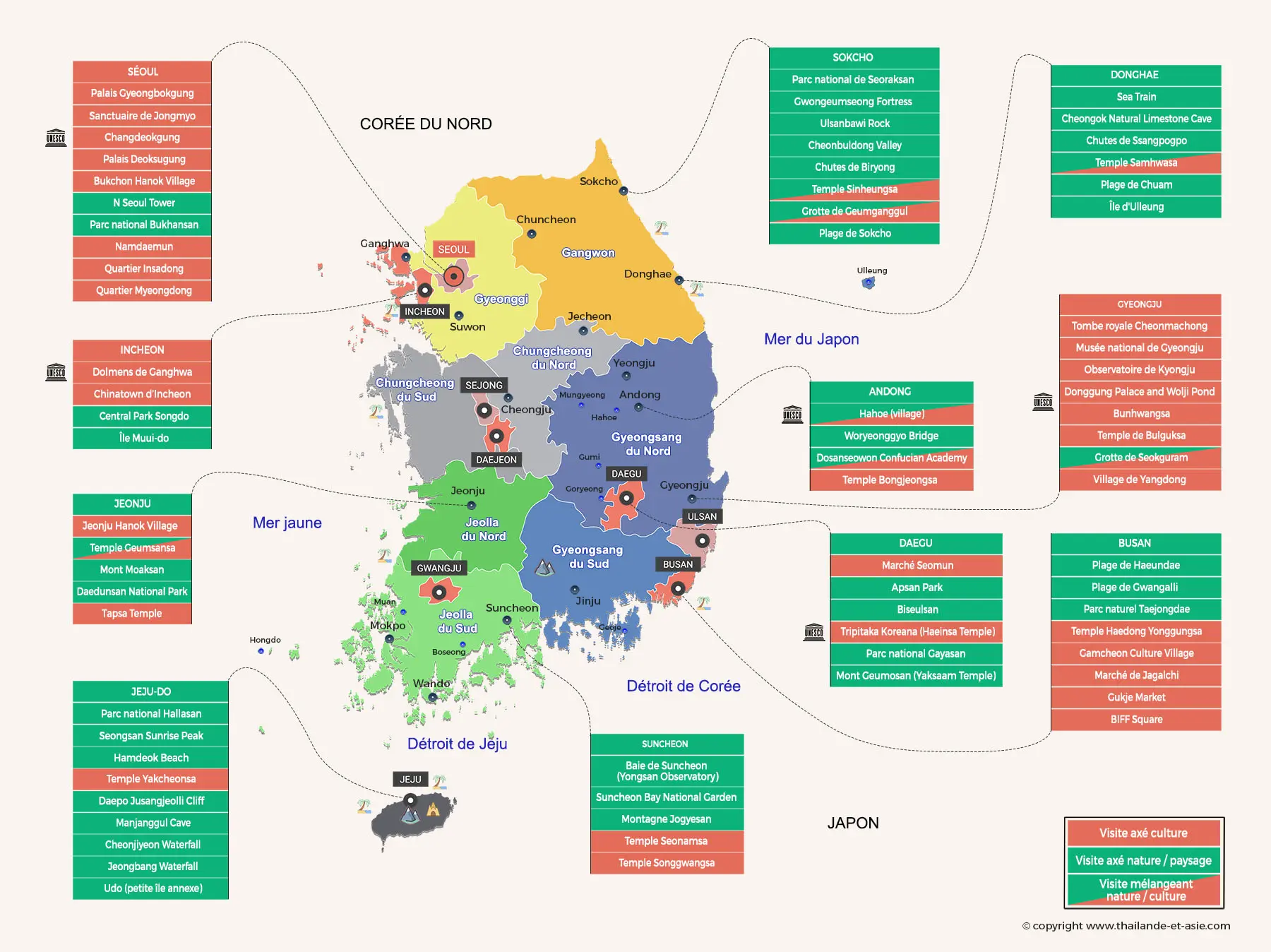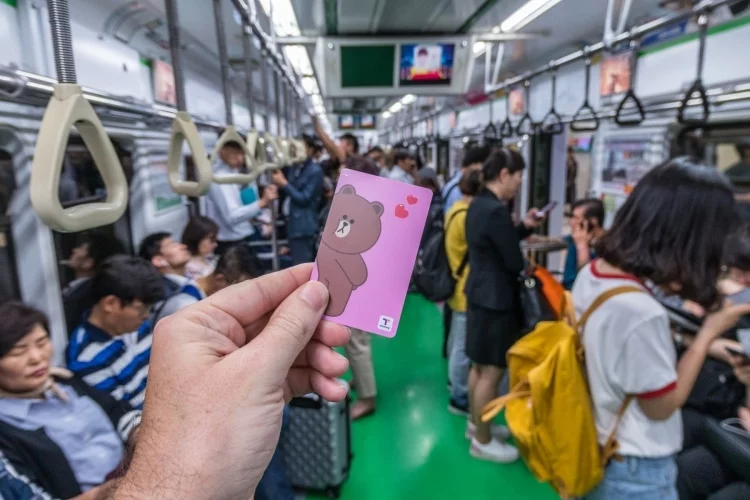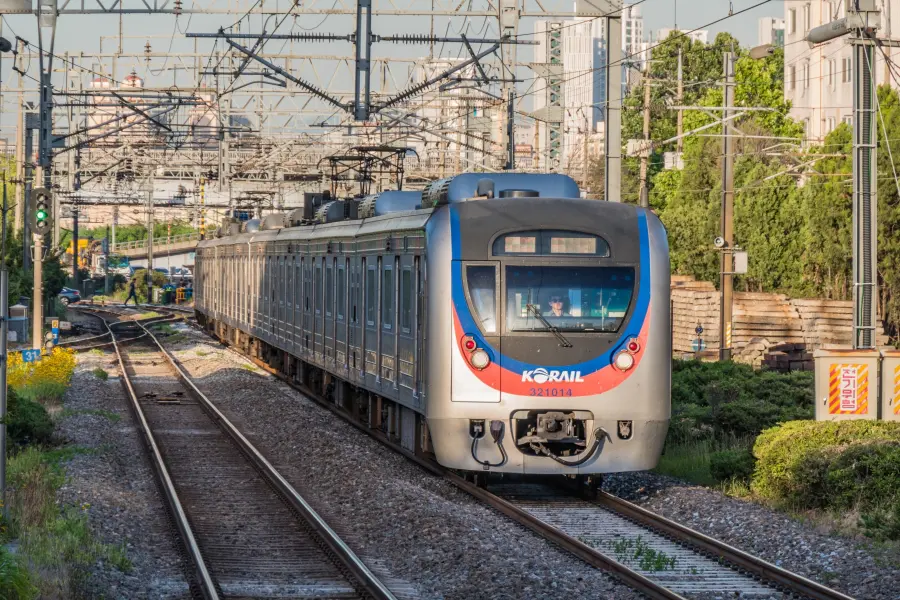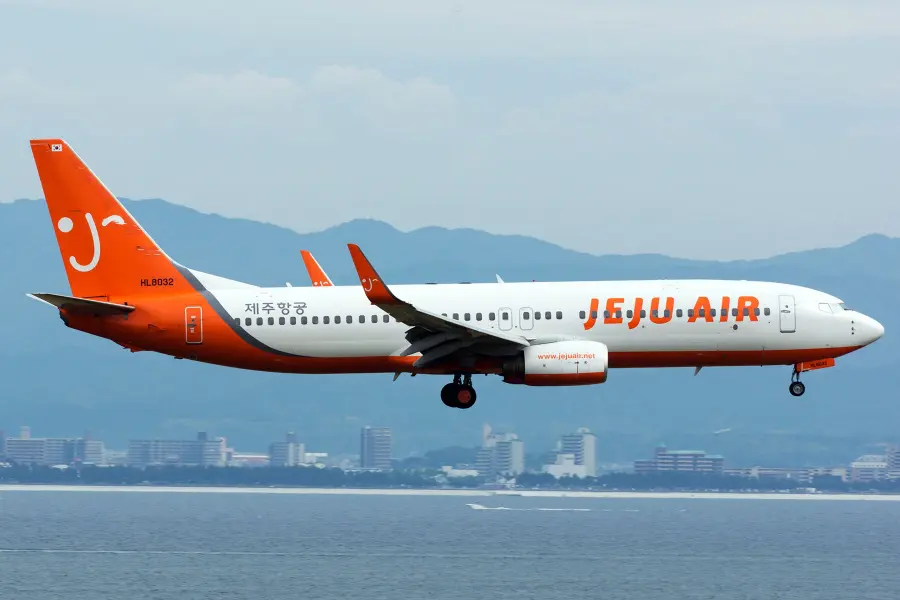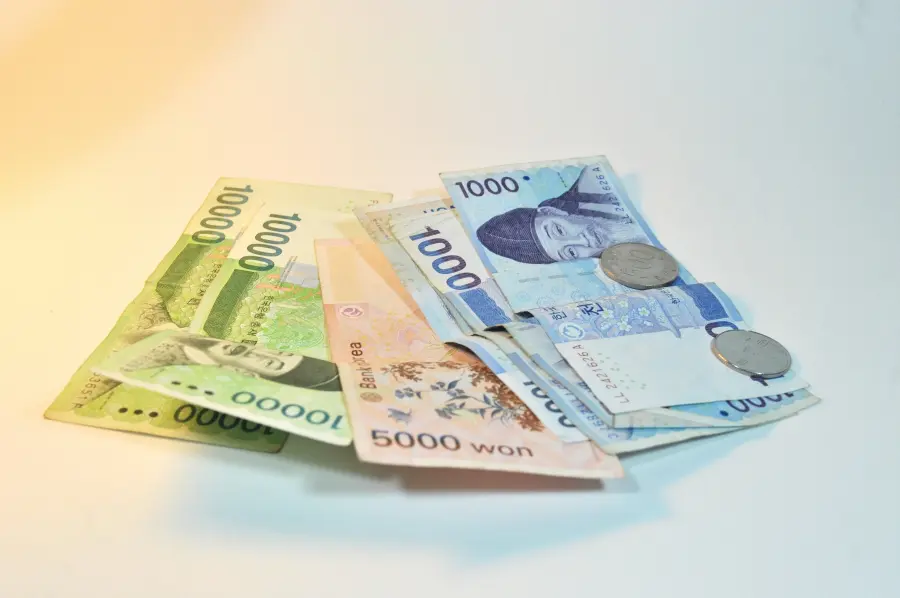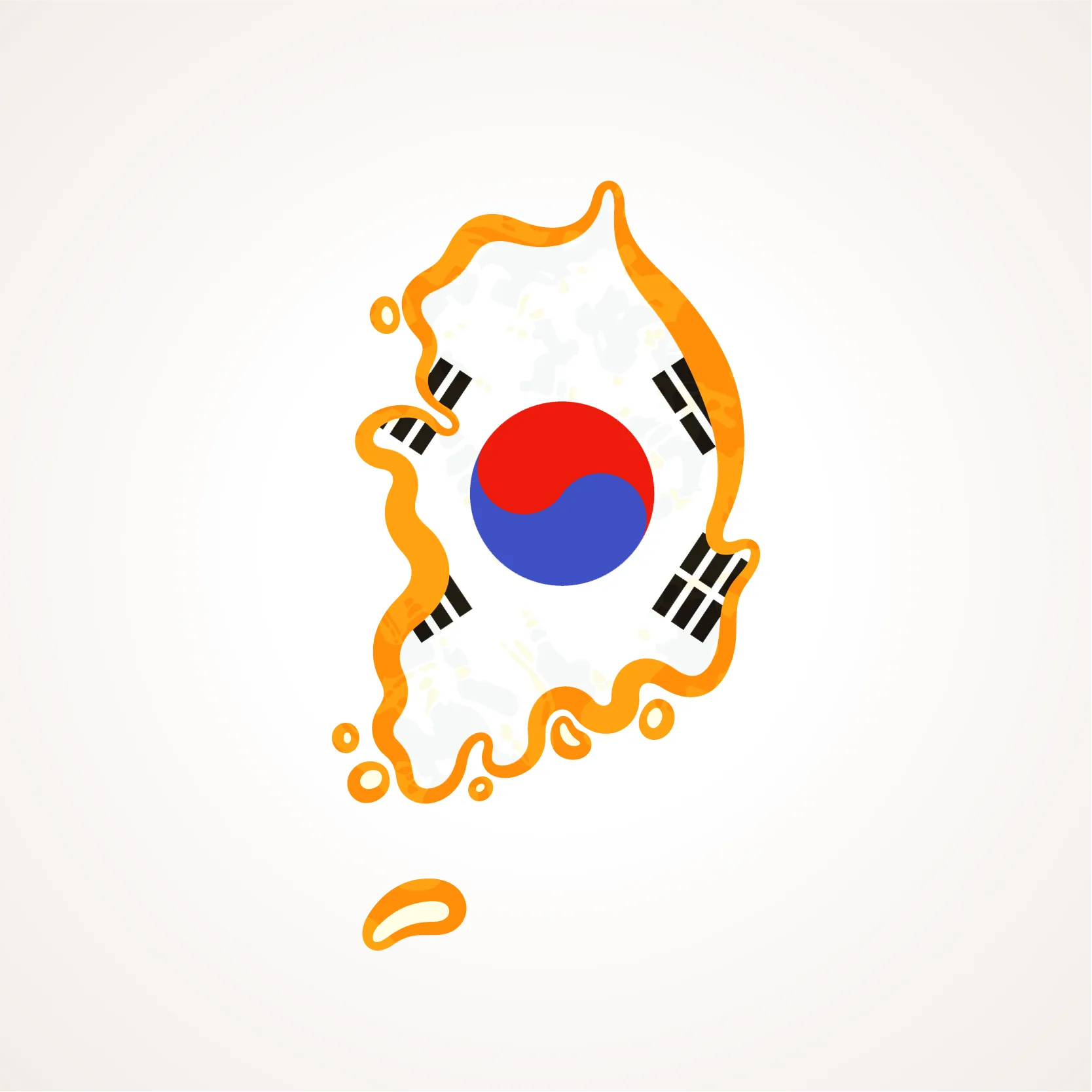Why visit South Korea?
If there's one destination that Europeans have largely overlooked until recently, it's South Korea, overshadowed by its Japanese neighbor. And honestly, I'm the first to admit it: it wasn't a country on my "list" of priorities.
It's worth noting that in the meantime, soft power has played a role, and interest in South Korea has been boosted by K-pop culture, K-dramas, and also its cuisine, leading to a significant increase in the number of visitors, particularly from France. Ironically, in our case, it was our next destination after our visit to… Japan.
The comparison was still fresh, and that's where South Korea surprised me. Yes, you sometimes find familiar elements in the architecture, yes, the Chinese influence is there, but Korean culture has its own personality, neither a copy of Japan nor a derivative of China: a unique and coherent blend, just like its language and writing system, which sets it apart from its close neighbors.
I went without any particular expectations, and that's often the best way to get swept up in it. People mostly remember its recent history—Japanese annexation, the Korean War, the North/South division—but the country also has a millennia-old heritage, which is particularly evident in Gyeongju, former capital of the Silla kingdomThat's when I truly realized how much more Korea is than just its modern period.
Our only slight regret is that our trip was quite focused on culture and not so much on "landscapes," so even though we crossed the country from north to south, from Seoul to BusanI don't remember any breathtaking panoramic views (although we did see some nice spots, particularly in Andong). The capital, Seoul, was actually a very pleasant surprise: old neighborhoods, palaces, temples, narrow streets, mountains all around… with just that slightly kitschy aspect of wearing traditional clothing to visit historical sites, like in Japan or Thailand.
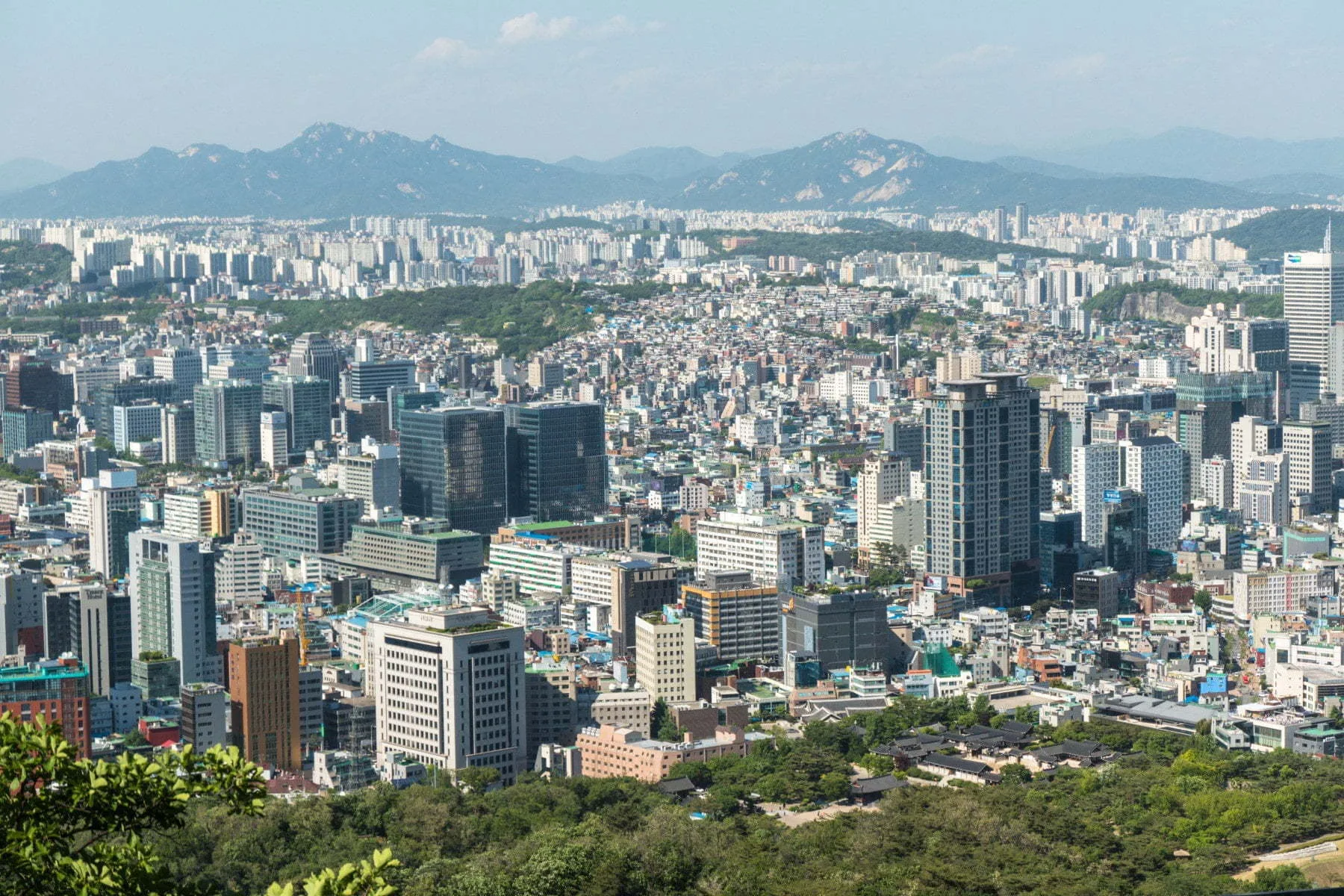

The country isn't huge in itself, but I think it deserves minimum two weeks if you want to enjoy it properly. In ten days, we had to make choices, and Jeju, the volcanic island to the southwest, will stay for another time.
Overall, I remember that the food is good, travel is easy, and we have a very positive impression of this stay in Korea — to the point that a return, one day, is clearly not ruled out.
- The food was generally good and quite cheap, but…
- The country is very clean and seems quite safe.
- The palaces and historic districts are really pleasant to visit.
- The blend of tradition and modernity that works well in Seoul
- Ease of inter-city travel.
- … Restaurants serving small plates didn't always satisfy me
- The atmosphere can sometimes be a little "cold" depending on the region (less warmth in the welcome than in Southeast Asia)
- Not much of a "wow" factor in terms of scenery if you like spectacular mountains.
- The overall cost of the trip can quickly escalate
Short stay: For most European citizens (France, Belgium, Luxembourg, Switzerland, etc.), it is not necessary to obtain a visa for a stay of up to 90 days for tourism or sightseeing purposes. An electronic authorization K-ETA However, it is required in many cases before departure.
The usual requirement is to have a valid passport. Note that for South Korea, there is no minimum passport validity period beyond the duration of your stay.
Stays exceeding 90 days (studies, work, Working Holiday Visa…) A specific visa is then required, which must be applied for before departure. Different types of visas exist: student (D-2, D-4), Working Holiday visa (H-1 program) for young people, employment visa, etc.
The Working Holiday Visa (WHV Korea)
The Working Holiday Visa (WHV) allows you to stay in South Korea for up to one year, travel freely, and hold certain jobs. Some general rules:
- Be aged 18 to 30 at the time of application (depending on nationality).
- Not having already obtained a Working Holiday Visa for this country.
- Provide proof of medical insurance covering the entire duration of the stay.
- Present a return ticket or proof of sufficient funds.
- Certain professions are not permitted (show business, entertainment, regulated professions, etc.).
For detailed instructions, consult the official resources of the Korean embassy or Specialized guides for Working Holiday Visas.
South Korea enjoys a temperate climate, with four distinct seasons like in Europe. However, the country's topography and geographical location create some differences between the north and the south.
- North : continental climate, with hot and humid summers, and winters that can be harsh due to cold winds from Siberia.
- South : humid subtropical climate, marked by intense monsoon rains and hot, humid summers. Winters are milder on the coasts, but cooler inland, often in mountainous areas.
To detail a little:
Spring — Ideal temperatures, between 18 and 23°C. It's the flowering season (including cherry blossoms in early April). You can also attend festivals: for example, we had the Sands Festival in Busan, and the beautiful Lantern Festival in May for Buddha's birthday. Note: rain sometimes returns as early as May on the East Coast.
Summer — Heavy, humid heat, regularly above 30°C. It is the rainy season (jangma), with heavy rainfall and some possible typhoons in the south of the country.
Autumn — The favorite season for Koreans. Mild temperatures (10 to 20°C), little rain, and stunning scenery: red, yellow, and orange mountains. It's also the time of Chuseok (late September / early October), the harvest festival, when many locals leave to join their families: some towns empty out and some businesses close.
Winter — Cold and dry season. Unless you're a fan of snow or skiing, it's rarely the ideal time to travel. Clear skies but sometimes bitterly cold.
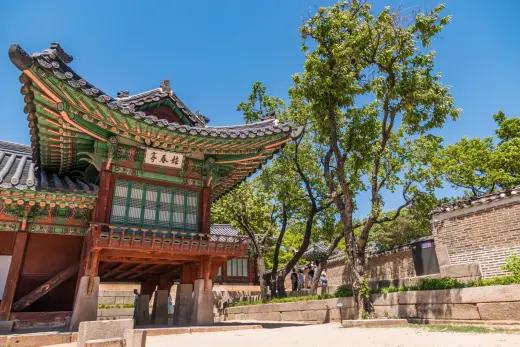
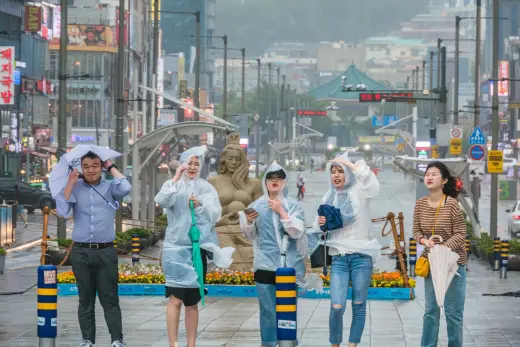
Best time to visit South Korea
Generally speaking: spring and autumn.
That was actually the time of year we were there (after mid-May). Beautiful weather in Seoul, pleasant temperatures throughout our stay. In Busan, further along in the season, we had one rainy day—typical on the East Coast in May—but it didn't bother us too much.
→ Spring brings blooms, and even if it's less "postcard" than Japan, there are some very beautiful spots.
→ Autumn, on the other hand, offers a magnificent spectacle with multicolored forests, which makes it such a popular time.
In summary, the best times to travel to South Korea are:
- April – May: Flowering, mild and generally sunny weather
- September – October: After the monsoon, pleasant temperatures and autumnal landscapes
| Month | Minimum temperature | Maximum temperature | Rain | Sunshine |
|---|---|---|---|---|
| Jan. | -6 ° C | 2 ° C | 21mm | 5 p.m. |
| Feb. | -3 ° C | 5 ° C | 25mm | 6 p.m. |
| Mars | 2 ° C | 10 ° C | 47mm | 6 p.m. |
| Apr. | 8 ° C | 18 ° C | 65mm | 7 p.m. |
| Mai | 13 ° C | 23 ° C | 106mm | 7 p.m. |
| June | 18 ° C | 27 ° C | 133mm | 6 p.m. |
| Jul. | 22 ° C | 29 ° C | 395mm | 4 p.m. |
| August | 22 ° C | 30 ° C | 364mm | 5 p.m. |
| Sept. | 17 ° C | 26 ° C | 169mm | 6 p.m. |
| Oct. | 10 ° C | 20 ° C | 52mm | 6 p.m. |
| Nov. | 3 ° C | 12 ° C | 53mm | 5 p.m. |
| Dec. | -3 ° C | 4 ° C | 22mm | 5 p.m. |
WEATHER — Regional Variants
| Region / Month | Jan. | Feb. | Mars | Apr. | Mai | June | Jul. | August | Sept. | Oct. | Nov. | Dec. |
|---|---|---|---|---|---|---|---|---|---|---|---|---|
| North (Seoul) | OK, fresh | OK, fresh | mixed | Ideal | mixed | mixed | To avoid | To avoid | mixed | Ideal | Ideal | OK, fresh |
| South (Busan/coast) | Mild mixed | Mild mixed | Ideal | Ideal | mixed | mixed | To avoid | To avoid | mixed | Ideal | Ideal | Mild mixed |
| Jeju (island) | Mild mixed | Mild mixed | Ideal | Ideal | mixed | mixed | To be avoided (typhoons) | To be avoided (typhoons) | Avoid (possible typhoons) | Ideal | Ideal | Mild mixed |
The country is generally mountainous: if you like rolling landscapes, you'll be in heaven. In our case, we didn't always have time to linger over the views because there were so many historical sites — in particular listed by UNESCO — which were worth the detour. But between mountains, temples, Buddhist heritage and some ultra-dynamic cities, there is plenty to do.
Administrative divisions
South Korea has 17 entities : 9 provinces (-do), 6 metropolitan cities (-gwangyeoksi) and 2 cities with special status : Seoul et sejongThis map provides the main landmarks useful for planning your route.

Since it's not necessarily "meaningful" to detail each province, here's how I grouped the visits: five major areas, with Seoul separate and Jeju Island presented separately for clarity.
1) Seoul: the capital
A megacity of contrasts where royal palaces, museums and creative districts interact. You go from the hanok alleyways of Bukchon to the neon lights of Myeongdong, from the urban stream of Cheonggyecheon to the ramparts on the hills, with night views from the N Seoul Tower.
- Palaces & UNESCO sites : Changdeokgung & Jongmyo (book the Secret Garden), Gyeongbokgung (changing of the guard) Deoksugung (Western-style mix of stone and bricks).
- Accompanied : stream of Cheonggyecheonsegments of battlements (passages to Ihwa Mural Village).
- Neighborhoods & Markets : Insadong (galleries/ceramics) Myeongdong (shopping & street-food) hongdae (outputs), Gangnam (southern chic), Namdaemun (historical market).
- views : N Seoul Tower ; at sunset, lovely light on the Bukchon side.
Around Seoul : DMZ/JSA (subject to conditions), fortress of Namhansanseong (UNESCO), mountains of Bukhansan (marked trails).
2) NORTHWEST: INCHEON & GYEONGGI (Outside Seoul)
This area encompasses the immediate hinterland of Seoul up to the coast of Incheon, where the international airport is located. It's not just a destination: it easily combines heritage sites (listed city walls), nature breaks, and small islands accessible for day trips.
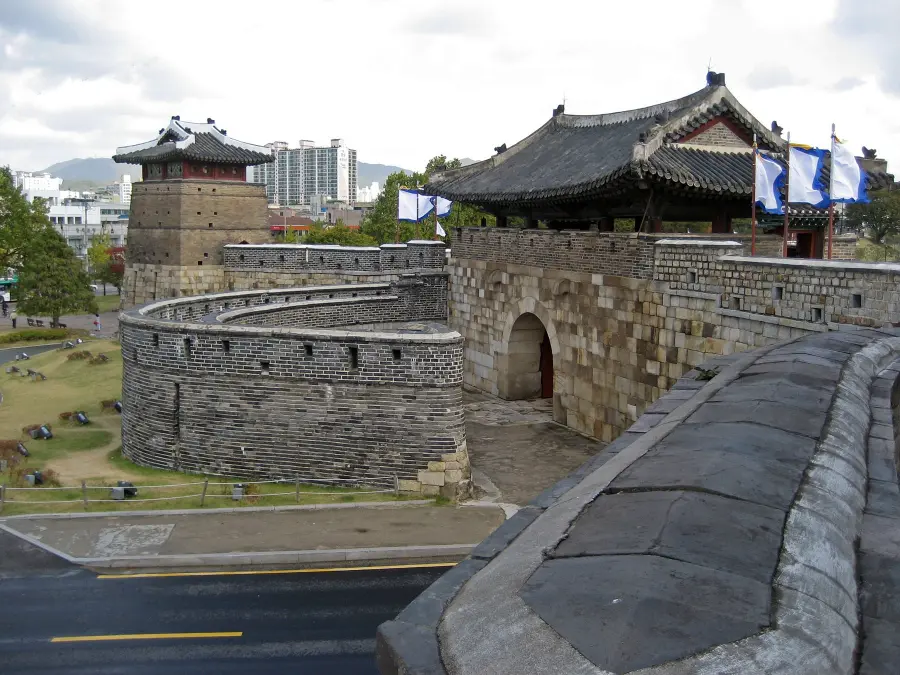
Gyeonggi is home to two fortresses listed as UNESCO World Heritage Sites : Hwaseong south of Seoul, ideal at the end of the day, and Namhansanseong on the wooded ridges to the southeast.
- Suwon – Hwaseong Fortress : panoramic loop on the ramparts, sunset lights.
- Namhansanseong : ramparts on the ridge, open views over the metropolis; shaded paths.
Nature walks & activities (Gapyeong, Nami, Pocheon, Gamaksan)
- Gapyeong: Garden of the Morning Calm; rail-bike along the river.
- Nami Island: avenues of ginkgo trees, easy walk (very popular on weekends).
- Pocheon: Art Valley (former quarry redeveloped), Bidulginangpokpo waterfall.
- Gamaksan: trail with suspension bridge and views of the hills.
Incheon — islands & new town
- Muui-do: a short getaway near the airport (beaches, trails).
- Ganghwa Dolmens (UNESCO).
- Chinatown (historic district).
- Songdo Central Park: canals, promenades, contemporary skyline.
3) NORTHEAST: GANGWON (Mountains & Coastline)
A province of wooded hills and granite ridges (like much of the country in the end), Gangwon is a playground for hikers (superb autumn foliage) with, on the coast, small beaches and easily accessible cliffs.
Around Sokcho, the Seoraksan National Park It features well-marked trails, waterfalls, and clear views of rocky peaks; further south, the coast towards Donghae It alternates between footbridges, temples, and coves. Generally, where there are "reliefs," there are caves, and the region is no exception: notably, it features the pair Hwanseongul Cave & Daegeumgul Cave, located in the mountain range of Deokhangsan.
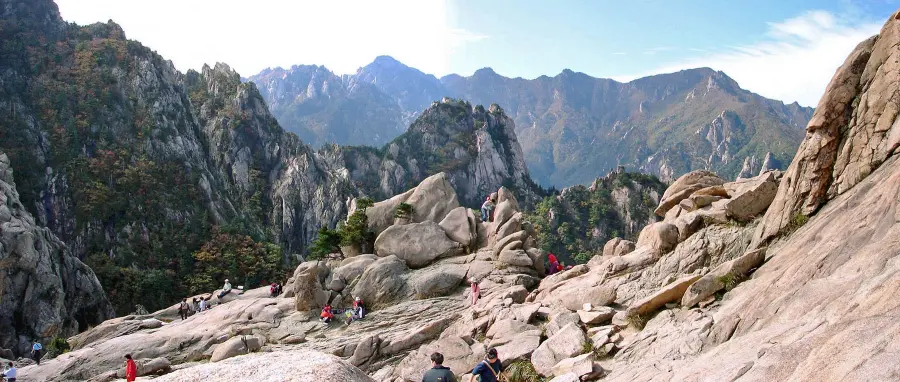
If you like stunning views, head to Ari Hills Resort Skywalk Observatory (Byeongbangchi)famous for its U-shaped meander — the skywalk is not free though.
Seoraksan National Park
- Ulsanbawi & Biseondae (panoramas, sculpted granite).
- Cable car (quick access to viewpoints).
- Yukdam & Biryong Waterfalls.
- Best season for colours: October–November.
East coast: towards Donghae
- Chuam Beach & footbridge over the cliffs.
- Samwhasa Temple (valley, gentle walk).
- Ssangpokpo Twin Falls.
- Sea Train from Gangneung (scenic coastline).
4) CENTER OF THE COUNTRY: CHUNGCHEONGBUK & CHUNGCHEONGNAM
A pivotal region between Seoul and the South, Chungcheong offers a blend of listed mountain temples, tranquil valleys, and several major historical sites linked to the Baekje Kingdom. It's a far cry from the rugged East Coast: here, the atmosphere is gentler, more rural, with accessible mountain ranges and modest towns that serve as good bases.
To the north, around Cheongju and Jecheon, the landscapes revolve around the Mount Sobaeksanwinding rivers and several famous caves (including Gosu Cave(often the most convenient to visit). It also contains two Sansa temples listed as UNESCO World Heritage Sites: Beopjusa (in the heart of Songnisan National Park) and Guinzain a narrow valley.
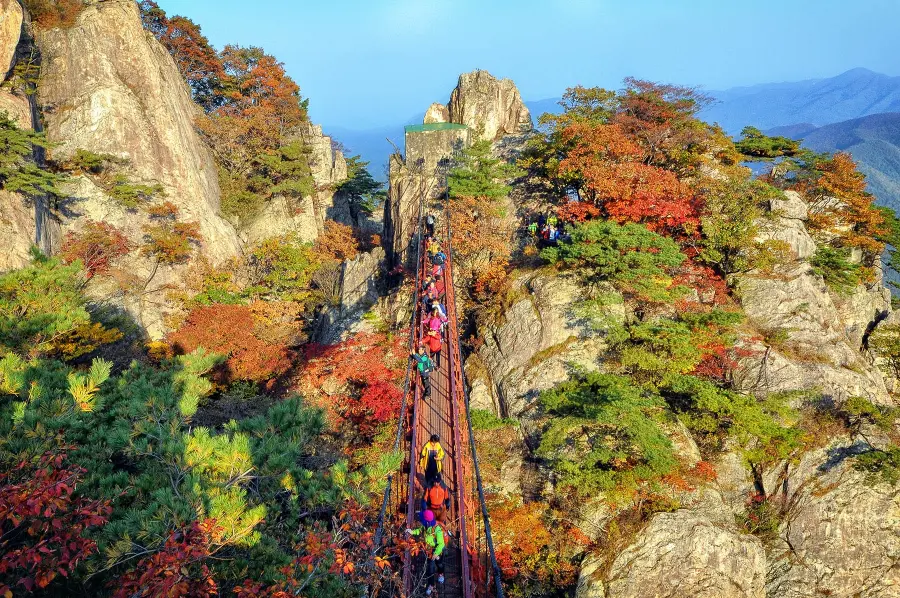
Further south, the province of Chungcheongnam is home to the main sites linked to the Baekje kingdom, notably in Buyeo et Gongju : fortress, tombs and listed remains. On the nature side, the region also boasts beautiful autumn colors, particularly around the Daedunsan Provincial Park.
Chungcheongbuk (North): temples & mountains
- Beopjusa (UNESCO): large complex in the middle of the mountains, gateway to Songnisan National Park.
- Gosu Cave (Danyang): the most well-known and easiest-to-access cave.
- Guinza : a vast modern complex nestled at the bottom of a valley.
- Dodamsambang Peaks : three rocky peaks in the middle of the river, a photogenic spot.
Chungcheongnam (South): Baekje & landscapes
- Gongju Gongsanseong fortress & royal tombs.
- Buyeo : National museum, relics of the Baekje kingdom.
- Magoksa (UNESCO): Sansa temple in a peaceful valley.
- Daedunsan Provincial Park : autumn colours & suspension bridge.
5) SOUTH-EAST: GYEONGSANGBUK & GYEONGSANGNAM (temples & Silla heritage)
On the East side, we enter the historical heart of the Silla kingdom Listed mountain temples, traditional villages, rolling landscapes, and a few vibrant cities. The Buddhist heritage is omnipresent: Sansa temples (UNESCO), villages of ancient lineages, sanctuary caves… The scenery alternates between tranquil valleys and large modern cities like Daegu, Ulsan, or the famous Busan, certainly the most well-known.
In the north (Gyeongsangbuk), there are several UNESCO World Heritage sites, notably in Gyeongju (the Bulguksa Temple and Seokguram cave) or near Andong, with the traditional village of HahoeFor those who like the “classic” landscapes of Korea, the Namsan Mountain It offers statues, small pagodas and gentle paths around the city.


Further inland, still around Andong, one can visit several academies seowon classified, including Dosanseowon et Byeongsan-seowonAnd for those curious and looking for a slightly different kind of place: the island of Ulleung-do, off the coast of Pohang, is worth a visit for its steep cliffs and unspoiled nature.
In the south (Gyeongsangnam), the atmosphere becomes more maritime: Geoje, Oedo The coasts around Tongyeong and Sacheon are among the most popular getaway destinations. Jirisan National Park dominates the center of the province, perfect for hiking. And on the Daegu side, major temples such as Haeinsa et Tongdosa (both Sansa, UNESCO-listed) are must-see destinations.
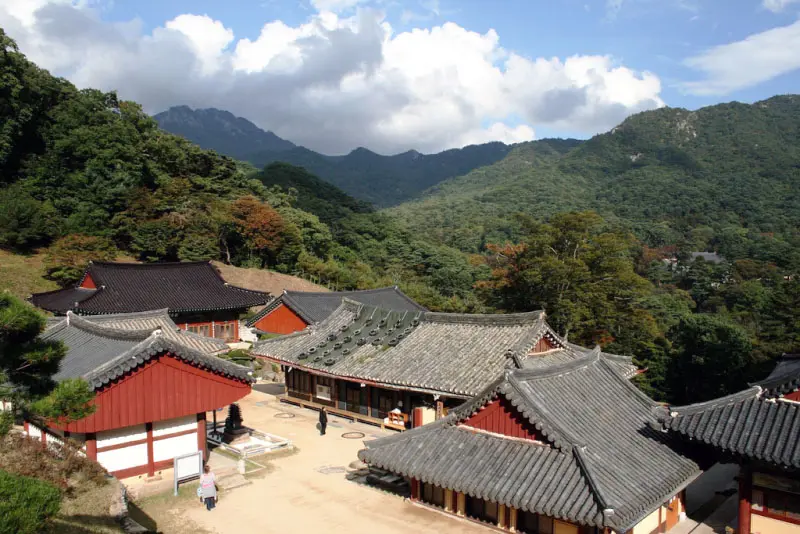
Gyeongju & surrounding area
- Bulguksa (UNESCO): emblematic temple of Silla.
- Seokguram Cave Monumental Buddha facing the sea.
- Cheomseongdae : oldest observatory in Asia.
- Wolji Pond / Donggung Palace : superb in the evening.
- Mount Namsan Buddhist statues, small pagodas, gentle hikes.
- Yangdong Village (UNESCO): traditional clan houses.
Busan & the Southeast Coast
- Haedong Yonggungsa : temple by the sea (UNESCO).
- Haeundae : large beach, sand sculpture festival.
- Gwangalli : view of the Gwangan bridge.
- Gamcheon Culture Village : colorful terraced houses.
- Jagalchi Market : fish & street food.
- Taejongdae : cliffs & walk at the end of Yeongdo Island.
6) SOUTHWEST: NORTH JEOLLA & SOUTH JEOLLA (Nature, temples & villages)
The Jeolla provinces are often less visited than the rest of the country, even though they encompass some of the most harmonious landscapes in Korea: gentle mountains, ancient forests, isolated temples, hanok villages and even some magnificent coastal parks.
Around jeonjuThere are several mountain ranges renowned for their autumn colours – Naejangsan, Deogyusan or, Daedunsan (and its suspension bridge). The city itself remains a beautiful stop to discover one of the most photogenic hanok districts in the country.
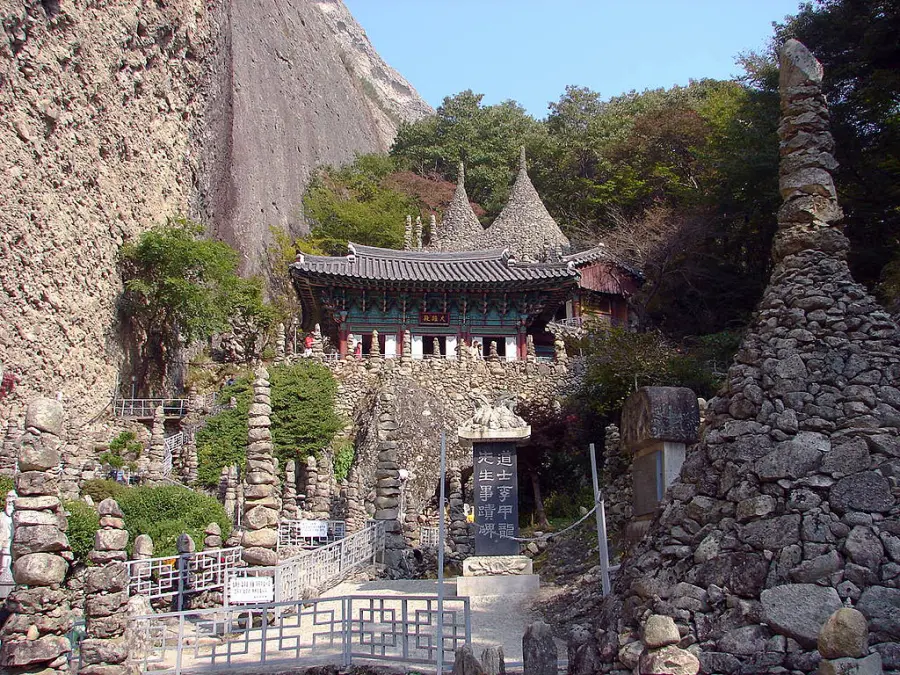
Further south, towards Gwangju and Suncheon, the mountains give way to wetlands, gardens, temples, and archipelagos scattered along the coast. The bay of Suncheonthe historic villages, as well as the temples Seonamsa et Songgwangsa (in the Jogyesan massif) are superb visits, especially if you like quiet and wooded landscapes.
On the southwest coast, the islands offer a different, more isolated atmosphere: Hongdo and its red cliffs, fishing villages, and easily accessible small coves.
Jeonju & North Jeolla — temples, mountains & villages
- Jeonju Hanok Village — traditional neighborhood, photogenic alleyways.
- Naejangsan National Park — autumn colours, temples, easy trails.
- Deogyusan National Park — gentle alpine landscapes, local resort in winter.
- Daedunsan Provincial Park — suspension bridge & rock walls.
- Mount Maisan & Tapsa Temple — stone pagodas, an unusual site.
- Gochang Dolmen Site (UNESCO) — vast area of dolmens, Gochangeupseong fortress.
South Jeolla — gardens, temples & archipelagos
- Suncheon Bay Nature Reserve — fields of reeds, bird watching.
- Suncheon Bay National Garden — themed gardens, pleasant stroll.
- Suncheon Drama Filming Site — a reconstructed village for dramas.
- Seonamsa Temple — stone bridge, forest, Jogyesan massif.
- Songgwangsa Temple — historic monastery, near the lake.
- Hwasun Dolmen Site (UNESCO) — a vast complex of dolmens.
- Unjusa — sculptures and Buddhas carved in stone.
- Dadohae Archipelago — islands & cliffs (including Hongdo).
- Gwangju — Soswaewon gardens & hikes in Mudeungsan.
7) AN ISLAND APART: JEJU
This is our biggest regret to date. We didn't have enough time to visit Jeju, the country's large volcanic island, a UNESCO World Heritage Site renowned for its unique geological landscapes with ancient craters, lava tubes, basalt cliffs, and tranquil beaches. The island's interior is dominated by the Mount Hallasan (1,947 m), an extinct volcano surrounded by dense forests and some of the most beautiful trails in South Korea.
On the foothills and the volcanic plateau, there are several secondary mountains called mouth, some of which offer very beautiful panoramic views (such as Geomun OreumThe eastern part also contains several formations of geological interest and a set of impressive lava tunnels.

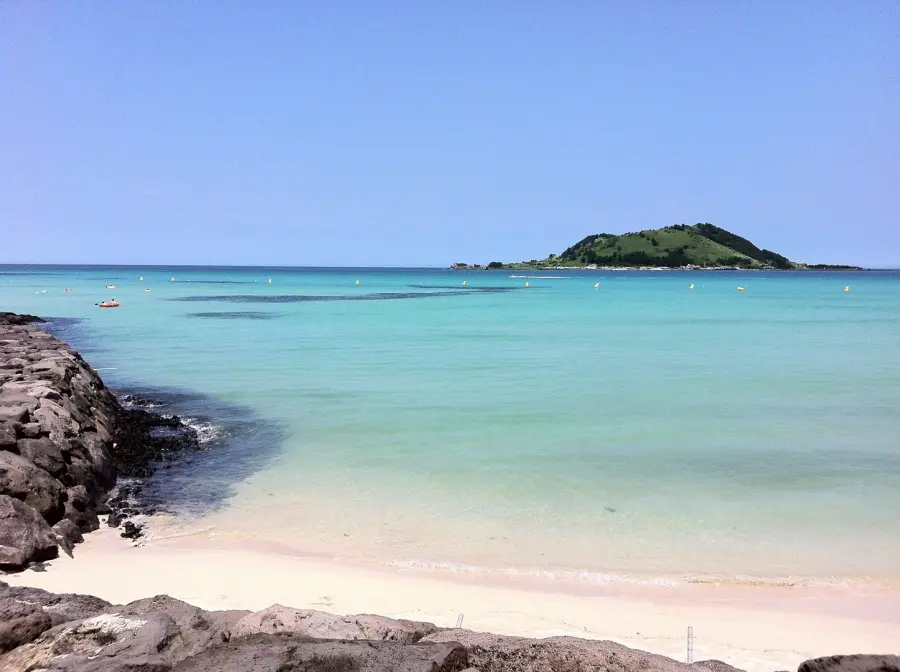
Jeju's rugged coastline alternates between coves, mint-milk-colored beaches, black cliffs, and waterfalls plunging directly into the sea. It is also here that one encounters the Haenyeo, the island's famous female divers, a cultural symbol still alive despite the years.
Volcanoes, craters & lava tunnels
- Mount Hallasan — summit of the country; hikes Seongpanak or Gwaneumsa.
- Geomun Oreum — ancient volcanic cone; views of Hallasan.
- Seongsan Ilchulbong (Sunrise Peak) — an iconic crater at sunrise.
- Manjanggul Lava Tube — spectacular lava tunnel (UNESCO).
- Jeju World Natural Heritage Center — museum + access to lava areas.
Coasts, cliffs & waterfalls
- Cheonjeyeon Waterfalls — three levels; Seonimgyo bridge nearby.
- Cheonjiyeon Waterfall — easily accessible from Seogwipo.
- Jeongbang Waterfall — a waterfall plunging directly into the sea.
- Jusangjeolli Cliff — spectacular basalt columns.
- Yongmeori Coast — sculpted cliffs; walk at low tide.
- Hyeopjae & Geumneung Beaches — clear waters, light sand.
- Mysterious Road (Dokkaebi Road) — a fun optical illusion.
- Haenyeo — possible encounters around Seongsan & Seogwipo.
South Korea in a nutshell
- Seoul: Gyeongbokgung Palace, Jongmyo Shrine, Bukchon, Myeong-dong, N Seoul Tower.
- Sokcho: Seoraksan National Park, Ulsanbawi, Sinheungsa Temple, valleys and waterfalls.
- Donghae: Chuam Beach, Samhwasa, Sea Train, cliffs and coastal paths.
- Andong: Hahoe village (UNESCO), Bongjeongsa temple, Dosanseowon, traditional market.
- Gyeongju: Bulguksa Temple, Seokguram Cave, Cheomseongdae Observatory, Royal Tombs, Wolji Pond.
- Jeonju: Jeonju Hanok Village, Tapsa Temple (Maisan), Deogyusan or Daedunsan as desired.
- Suncheon: Suncheon Bay, National Gardens, Seonamsa Temple, Songgwangsa Temple.
- Busan: Haeundae Beach, Gwangalli, Haedong Yonggungsa Temple, Jagalchi Market, Gamcheon Culture Village.
- Jeju: Mount Hallasan, Manjanggul Cave, Seongsan Ilchulbong, Hamdeok and Hyeopjae Beaches.
South Korea landmarks on a map
Below you will find a general overview with ideas for major sights to see in South Korea:
As is my custom for this column, I'll begin by detailing our experience with the chosen itinerary, which focused heavily on culture, including visits to many UNESCO World Heritage sites. I'll then offer other suggestions depending on the time you have available.
Our 10-day Itinerary
For this duration, it is an itinerary that seems to me to be minimally optimized to be able to travel the country from north to south, with the emphasis on the eastern part of the country.
In 10 days, we obviously had to make choices, so we missed some of the country's "must-see" places due to lack of time. I'm thinking particularly of Jeju Island, but we would have needed at least 3 or 4 more days. Despite this, I think this itinerary gave us a good overview of the country, at least for a first impression.
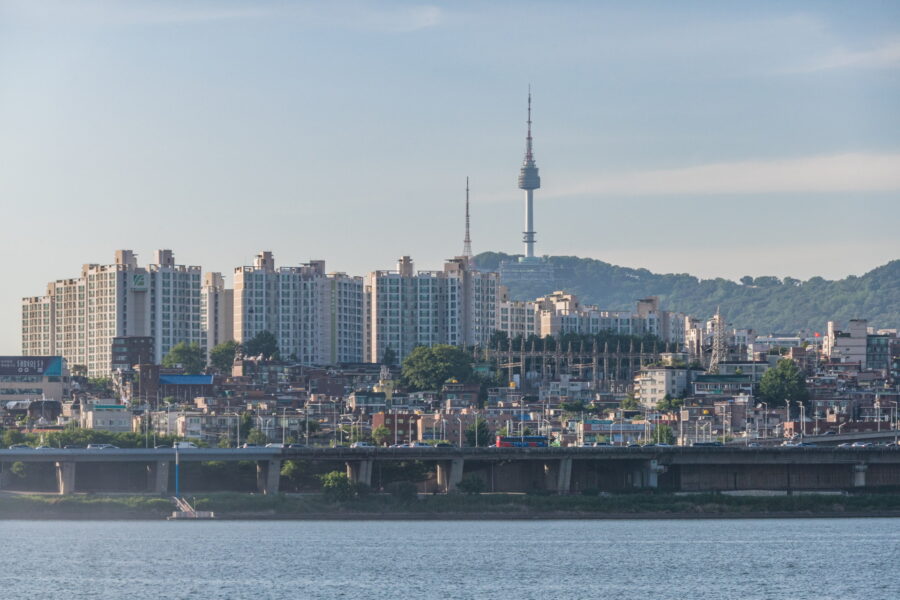
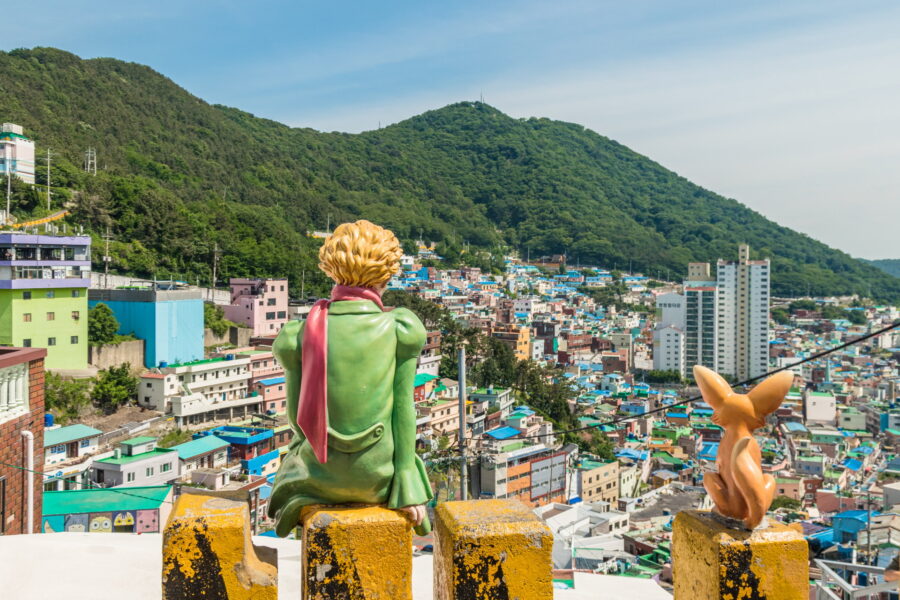
- Days 1–3 — Seoul : large palaces (Gyeongbokgung, Deoksugung), N Seoul Tower, Namdaemun, districts (Insadong, Bukchon, Myeong-dong, Gangnam).
- Day 4 — Andong : transfer by train, traditional village of Hahoe (UNESCO).
- Day 5 — Transfer to Gyeongju : Andong bus → Gyeongju, facility.
- Days 6–7 — Gyeongju : Bulguksa & Seokguram Cave (UNESCO), Royal Tombs, Cheomseongdae, Wolji/Donggung Pond.
- Days 8–9 — Busan : Haeundae & Gwangalli, Jagalchi market, Gamcheon Culture Village, Haedong Yonggungsa temple (Sands Festival depending on dates).
- Day 10 — Return to Seoul : Jongmyo Shrine, Changgyeonggung, last districts / shopping.
Short break ideas
If you have less time than I do, here are some ideas you can adapt. For a one-week trip, several options work well, the most obvious being centered on the capital, Seoul, and its surroundings.
And if you're looking for a short break for a "themed" week without having to travel a lot, two options also make excellent bases: Busan (coastal city, beaches + temples) and Jeju Island (nature, volcano and waterfalls).
1 week in Seoul & surrounding areas
- Day 1 : Seoul — Gyeongbokgung, Deoksugung, Namdaemun.
- Day 2 : Seoul — Jongmyo, Changgyeonggung, Bukchon.
- Day 3 : Seoul — Cheonggyecheon, Insadong, N Seoul Tower.
- Day 4 : Nature — Bukhansan National Park (hiking).
- Day 5 : DMZ / JSA (day trip).
- Day 6 : Suwon — Hwaseong Fortress (UNESCO) + evening in Gangnam / Myeong-dong.
- Day 7 Incheon — Muui-do Island ou Chinatown + Songdo Central Park.
Short version: replace J6–J7 with an escape to Seoraksan (Sokcho)
1 week in Busan
- Days 1–2 Haeundae & Gwangalli, walk to the Gwangan bridge.
- Day 3 : Jagalchi Fish Market, BIFF Square, Nampo-dong.
- Day 4 : Haedong Yonggungsa Temple (by the sea) + Igidae coastal park.
- Day 5 : Gamcheon Culture Village + skywalks (Oryukdo or Cheongsapo).
- Day 6 Day trip to Geoje ou Oedo (boat from Busan).
- Day 7 : Temple Beomeosa or hiking at Mount Geumjeongsan.
profile: beaches, cafes, markets, sea views and some major temples.
1 week in Jeju
- Day 1 : Seongsan Ilchulbong (sunrise), village of Seongeup.
- Day 2 : Manjanggul (lava tunnel) + northern beaches (Woljeongri / Hamdeok).
- Day 3 Southern Waterfalls: Jeongbang, Cheonjiyeon, Oedolgae.
- Day 4 : Hiking on the slopes of Hallasan (summit if weather OK).
- Day 5 Sector Jungmun — cliffs, museum/tea house O'Sulloc.
- Day 6 : Island of Udo (scooter or bicycle).
- Day 7 Beaches and cafes of the southern coast; market of Dongmun.
profile: 100% nature — volcanoes, cliffs, waterfalls and beaches.
Thematic ideas (5–7 days)
- Silla culture and heritage (Gyeongju + Andong)
• 2 days in Gyeongju: Bulguksa, Seokguram cave, Mount Namsan.
• 1 day in Andong: Hahoe village, Dosanseowon Confucian Academy.
• 1 day: Ulsan or Daegu to complete (Sansa temples: Tongdosa or Haeinsa). - Nature & hiking (Gangwon)
• Seoraksan (2 days): Ulsanbawi, Biseondae, Heundeulbawi.
• East Coast: Chuam Beach, Sea Train, Hwanseongul or Daegeumgul cave.
• Byeongbangchi Skywalk for a panoramic “postcard” view. - Cities & cafes (Seoul + Busan)
• Seoul (3 days): palace, Bukchon, markets, cafes of Seongsu & Yeonnam.
• Busan (2–3 days): Haeundae, Gwangalli, Gamcheon, Yonggungsa. - Beaches & slow travel (South & Jeolla)
• Geoje / Tongyeong: islets, sea views, Oedo (weather permitting).
• Suncheon Bay & Jogyesan: calm nature, temples, gardens.
• Possibility of extending to Boseong (tea plantations).
Target profiles: travelers who want a targeted immersion (culture, hiking, cafes, nature), without crossing the whole country.
2-week itinerary
If you have about two weeks, you can already create a very comprehensive itinerary, combining major cultural sites (Gyeongju, Andong, Sansa temples), a large coastal city like Busan, and some nature in the national parks. This amount of time allows you to travel at a relaxed pace while still covering the essentials of the country.
2-week itinerary (≈15 days)
- Days 1–4 Seoul — palaces, shrines, neighborhoods, museums.
- Day 5 : DMZ / JSA.
- Days 6–7 : Sokcho — Seoraksan National Park (hikes + waterfalls).
- Days 8–9 : Gyeongju — Bulguksa & Seokguram (UNESCO), historical sites.
- Days 10–11 : Busan — Haeundae / Gwangalli, Jagalchi, Gamcheon, Haedong Yonggungsa.
- Days 12–15 : Jeju — Hallasan, Seongsan Ilchulbong, Manjanggul, beaches (Hamdeok/Hyeopjae).
Tip: Remove the DMZ if you prefer to add a nature or beach day.
1-month itinerary
With a month, you can truly take the time to explore South Korea as a whole: the mountains of the northeast, the ancient kingdoms of the central region, the southern coast, and remote islands and temples. This allows you to balance cultural visits, beaches, hikes, and some lesser-known detours, without neglecting downtime between regions.
1-month itinerary
- Days 1–5 : Seoul — major classics + neighborhoods (adjust according to closing days).
- Days 6–9 : Gangwon — Sokcho & Seoraksan National Park, Sea Train, coastal stop (Gangneung/Donghae/Samcheok).
- Days 10–13 : Andong & Gyeongju — Hahoe (UNESCO), Bulguksa & Seokguram, royal tombs.
- Days 14–15 : Busan — Haeundae, Jagalchi, Gamcheon, Haedong Yonggungsa.
- Days 16–20 : Jeju — Hallasan, Manjanggul, Seongsan Ilchulbong, coasts & waterfalls.
- Days 21–26 : Jeolla — tea plantations (Boseong), Suncheon Bay, Gwangju (Mudeungsan), Damyang Bamboo Park, Naejangsan.
- Days 27–28 : Jeonju—Hanok Village; Daedunsan (suspension bridge, panoramas).
- Days 29–30 : Return to Seoul — additional sightseeing, shopping, Ganghwa-do dolmens if desired.
Transport: Prefer the train (KTX/ITX) and complete by intercity bus; Jeju by plane (fast) or ferry (slower).
Coming to South Korea
From France/Europe, the easiest way to arrive is via Incheon (ICN)Seoul International Airport. Alternatively: Gimpo (GMP) for some regional flights, Busan (PUS) ou Jeju (CJU) depending on your itinerary.
Direct flights from Paris (CDG)
- Paris ⇄ Seoul (ICN) — Air France, Korean Air (depending on the season): ~10:50–11:30 non-stop.
Price ranges (round trip, economy, indicative) low season ~600–900 € · mid-season ~€800–€1,200 Summer/Christmas ~1,200–1,500 €.
baggage : check the inclusion of checked baggage according to the fare (the "Light" classes do not always include checked baggage).
Via a stopover (often more choices)
Frequent routes via:
- Doha — Qatar Airways
- Dubai — Emirates
- Abu Dhabi — Etihad
- Istanbul, — Turkish Airlines
- Amsterdam — KLM · Frankfurt — Lufthansa
Typical durations : ~13–16h door-to-door depending on stopover.
Price ranges (round trip, economy, indicative) low season ~550–850 € · mid-season ~€700–€1,200 · high season ~€900–€1,200.
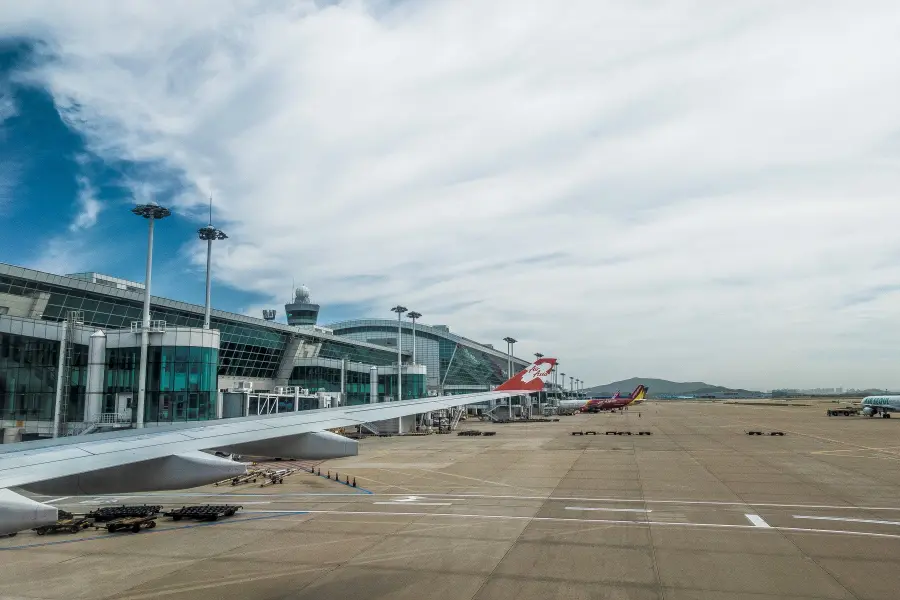
Which airport should I aim for depending on the itinerary?
- Seoul & North arrive at ICN ( GMP for regional flights).
- East Coast (Gangwon) : ICN + train/bus.
- Southeast (Gyeongju, Busan) : ICN + KTX, or PUS if flight is practical.
- Jeju Island : CJU (very frequent domestic flights from GMP/ICN and PUS).
Useful reference points
- Paris ⇄ Seoul (direct) ~11am Air France/Korean Air · Eco round trip ~€700–€1,200 depending on the period.
- Province (France) ⇄ Seoul via AMS/FRA/IST: ~13–16h · Round trip economy ~€650–€1,200.
- Airport transfer → Seoul : AREX Express ICN⇄Seoul Station ~43 min · Limousine Bus depending on area ~50–80 min.
Tip: if you follow up with a KTX (fast train) on the day of arrival, leave a margin (formalities, luggage, unforeseen events).
Search for a flight to South Korea
Traveling in South Korea
The country is not very large (≈ 400 km from north to south and 300 km (from east to west), it's easy to travel from one city to another without spending hours in transit. With a density of approximately 516 inhab./km²South Korea is very well served by bus and train: KTX/SRT for long journeys, intercity buses for the local network, then metro/bus/taxis in the city.
In practice, we combine bus for short/medium journeys and train For long distances. The subways of Seoul, Busan, Daegu, Incheon facilitate access to key areas and often make taxis unnecessary.
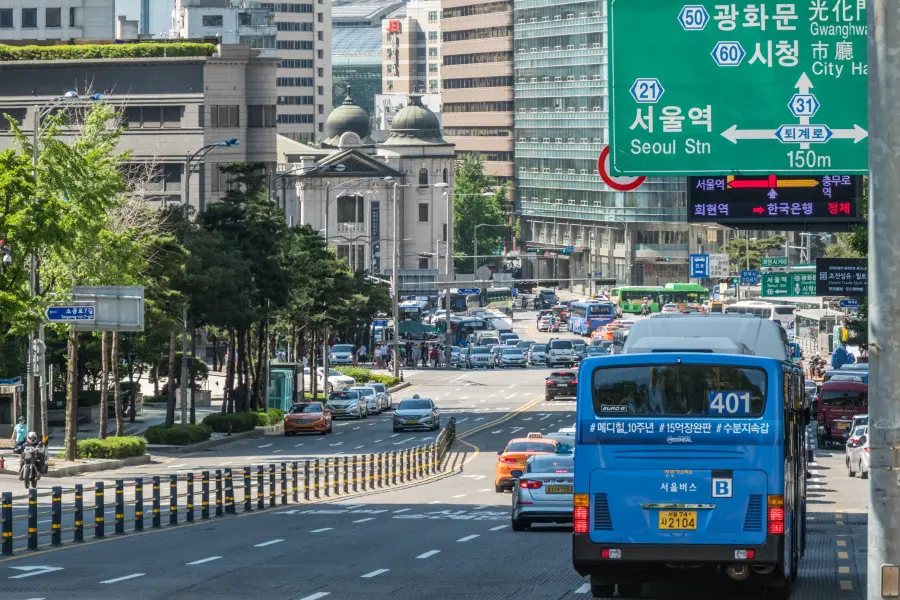
It's rare enough to mention, but we didn't need to rent a car or scooter like I usually do at some point during a trip, because everything was accessible by public transport. The only "vehicles" we used independently were bicycles, perfect for exploring Gyeongju.
A unique feature of South Korea is that, being technically still in a state of "war" with the North, the government does not open the country's map data via API to foreign companies like Google, which is why Google Maps is not very relevant in South Korea.
Hence the following alternatives:
- Offline maps (Android): detailed maps, visible bus stops/metro entrances – the most practical in my experience.
- Naver Map (Android ou iOS) / KakaoMap (Android): routes (normally in English), real-time if local data SIM card.
Road transport
In cities or between two regions, the road remains a simple and efficient way to get around. To cover the entire territory, the network ofintercity/express bus is a safe bet: frequent, punctual, cheap and often more direct than the train for some medium-sized cities.
In the city, urban buses take over, or taxis, which are affordable and easy to hail or book via an app. Renting a car is possible—especially useful in rural areas (Jeolla, Gyeongsang, mountains) or on Jeju.
City buses (color codes & fares)
However, Seoul's city buses are color-coded to help you navigate:
- Blue bus : they follow all the main lines of the capital.
- Green Bus : they serve secondary lines and main metro stations.
- Yellow bus : they usually do tours around certain main districts.
- Red bus : they connect with the neighboring suburbs of Seoul.
- Bus de nuit : explicit. These are specifically nocturnal lines.
How to use the buses and how much does it cost?
- Validation : beep on the way up et downhill (calculated per km).
- Reference prices :~ 1 300 ₩ (general bus) Daegu has an "express" ~ ₩1.
- Example Gyeongju → Bulguksa Temple (~15 km) ≈ 2 000 ₩ / pers.
- Information stops (e.g., Gyeongju): screens listing lines and positions in real time.
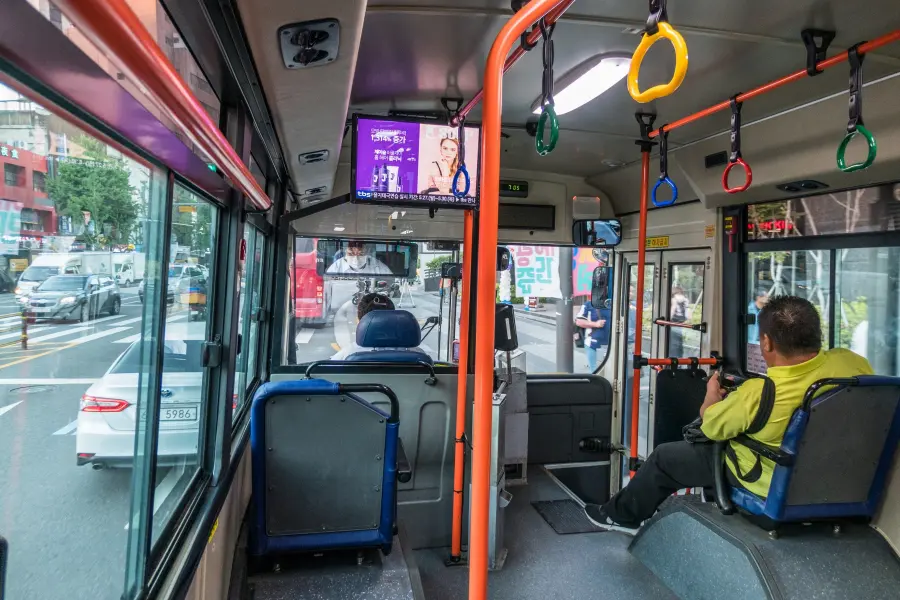
Intercity & Express Buses (national network)
There are two main types:
- Express Bus (Gosok – 고속버스) — connections direct between major cities (few stops), "general" / "premium" classes (wider seats, USB, sometimes IFE).
- Intercity bus (Sioe – 시외버스) — connect medium/small towns, with intermediate stops. Versions No stopping (non-stop) / going straight (direct) faster.

Reservations/schedules (KO/EN):
Price ranges / journey times :
- Real-life examples : Andong ⇄ Gyeongju (~140 km) ≈ 2,500 (~8 €) · Gyeongju ⇄ Busan (~80 km) from 2,500.
- Other examples:
- Seoul ⇄ Busan: ~25,000–40,000 (2h40–4h depending on traffic).
- Seoul ⇄ Gyeongju: ~25,000–40,000 (~3h30).
- Seoul ⇄ Sokcho: ~25,000–40,000 (~2h20–2h40).
Tip: The premium buses “우등/Udeung” (or “Premium/Prime”) have more space and are really comfortable — excellent value for money.
Taxis (types, fares & app)
The default app that you'll often see on websites is the one used by default by most Koreans. Kakao T, but the latter is not very "foreigner friendly" and often bugs on Android, so I'm giving you an interesting alternative.
- TABA Taxi to order a taxi anywhere.
There are 4 types taxis:
- Ilban (classic, orange/white/grey)
- Mobeom (deluxe, black with yellow trim)
- Jumbo (van)
- International (drivers speaking EN/JP/ZH).

Reference prices :
- Seoul : support ~3,800–4,800, then ~1,000–1,300/km.
- Busan : support ~2,500 (2 km), then ~700/km.
- Deluxe : departure ~2,500, increments ~200 / 144 m.
- ICN Airport → Seoul: 55,000–75,000.
Some additional information:
- Mark-up nighttime (~20%).
- Practical : meter reset, receipt possible, frequent card payment, T-money sometimes accepted, no customary tipping.
- To know : occasional refusals to run errands (too short/too far/end of service) — theoretically punishable by a fine.
- Credit cards accepted > 95% of the time.
- You can find out an estimate of the prices via this site: Number Taxi Fare
Bike rental
As I mentioned earlier, it was in Gyeongju that we had the opportunity to try out bicycle rentals. Initially, it was by chance, as it wasn't specifically planned, but on our way to our first destination, we passed a shop that had them. We thought it might be a good idea, as it would give us more time to explore the old town.
They also had scooters for rent, but as it was more expensive, we settled for the two-wheeled "manual" version, especially since I didn't have an international driving permit.
- During our visit, we paid 7,000 W (just over €5) per bike for the day.
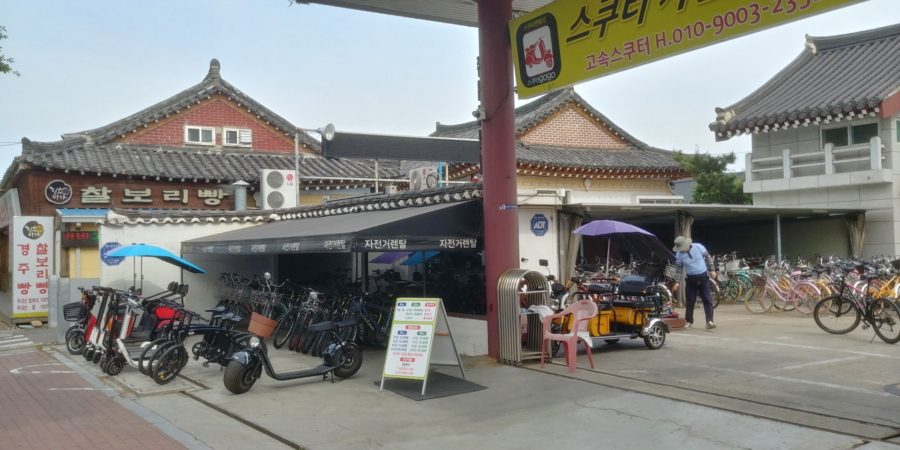
As in many major cities now (even Bangkok, believe it or not), you can find bike-sharing services like Vélib'. We saw them in Seoul, and I wouldn't be surprised if they were available in other large cities. I haven't looked at the prices, but I imagine they must be affordable.
Given the traffic we saw, it seems perfectly feasible to cycle in the city. When I saw them, it was coming out of the metro, which can be a perfect complement to reach a given point without having to walk (we could have done it the day we went to the river from the Gangnam district, crossing the Banpo bridge to get to the suburban train, because it was quite a walk).

Car rental (Jeju, countryside)
To rent, you can call on classic international rental companies such as Avis, Hertz etc. which are always safe bets in the event of disputes (although, no one is perfect). You also have local partners such as Lotte Rent-a-car, a sub-branch of Hertz a priori.
- Jeju : Renting simplifies everything, easy access to beaches, volcanoes, waterfalls.
- Prices: 50,000–80,000 / day.
- International driving permit required.
- Tolls around Seoul, not on Jeju.
Rail transport
Modern and punctual network: approximately 3,378 km of tracks (approximately half electrified). For major routes, preference is given to KTX (since 2004) and SRT (since 2016, departure) Suseo in Seoul). The "classic" trains (ITX/Saemaeul/Mugunghwa) cover the rest.
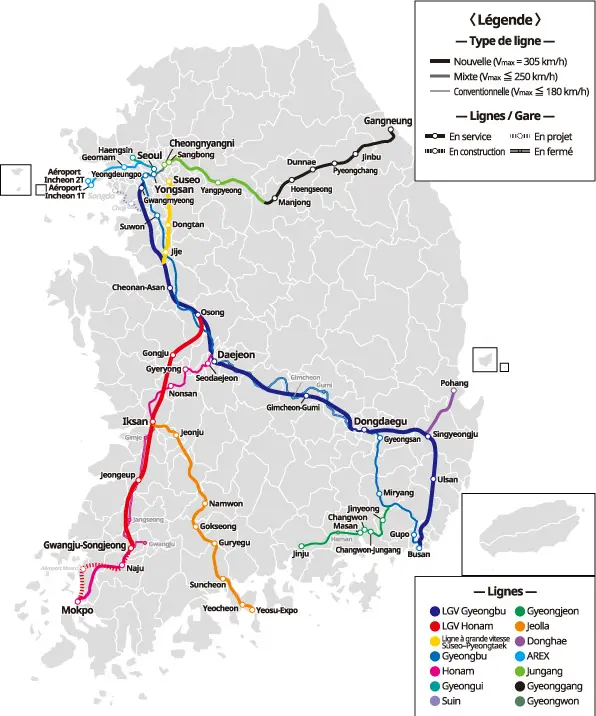
Train categories in Korea
There are four types of trains in Korea, depending on the number of stops and their speed:
- mugunghwa : This is the most common type of train in Korea, and the oldest (Mugunghwa has been in service since the 1960s). These local trains make stops at smaller stations than the KTX or ITX-Saemaeul trains.
- ITX-Saemaeul : These trains run on the Gyeongbu, Honam, and Gyeongjeon lines. ITX trains replace regular Saemaeul trains, at a slightly faster speed.
- Super Rapid Train (SRT) : As the name clearly suggests, these are "super" fast trains, which operate on the Gyeongbu and Honam lines from Suseo Station in Seoul (Gangnam district). Introduced in 2016, it has a top speed similar to the KTX.
- Korean Train Express (KTX) : The aptly named Korean Express Train, the KTX, entered service in April 2004. This high-speed train was designed to reach speeds of up to approx. 305 km per hour.

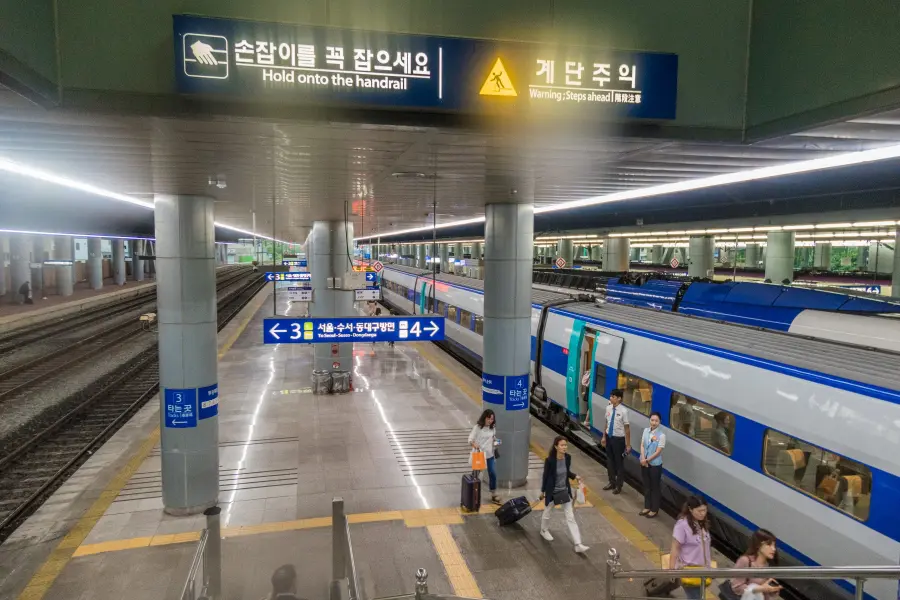
Durations & price benchmarks
- Seoul ⇄ Busan (KTX/SRT): ~2 pm - 20 pm · 3,800–4,800 (~€50–70).
- Seoul ⇄ Singyeongju (Gyeongju access): ~2–2 pm · 3,800–4,800 + local shuttle to town.
- Seoul ⇄ Daejeon (KTX): ~55–70 min.
- Seoul ⇄ Gwangju-Songjeong :~2 pm - 20 pm.
- Seoul ⇄ Gangneung (KTX-E): ~6:50 PM–8:00 PM · 3,800–4,800.
Journey times vary depending on the departure station (Seoul/Yongsan/Suseo) and stops.
Classes, onboard & stations
You'll generally find vending machines selling snacks and drinks on trains, along with clean restrooms and comfortable seating. Some trains (like the KTX-Sancheon) even have swivel seats, allowing you to face forward in any direction.
- Classes : Standard vs First (2+1 seats). Some KTX-Sancheon models have swivel seats.
- baggage : end racks + upper luggage racks (cabin suitcase OK).
- At the train station Clear signage, announcements in English. Arrive a little early.
Tickets, passes & reservations (official)
If you are already there, just go to the ticket office at the station and give your destination and the desired time if there are several choices. There are also machines for express trains running around Seoul. This is particularly the case for the train connecting Incheon airport to the city center, very convenient since it runs directly into the city.
If you wish to book online, you can do so up to one month in advance, but no further. You can use the official websites:
- korail : letskorail.com (KTX/ITX/Express) · Korail/KorailTalk apps.
- SRT : etk.srail.kr (Suseo departures).
If you plan on seeing a large part of Korea by train, it is worth getting a Korail Pass, similar to the popular JR Pass in their neighbor Japan. In Korea, they offer passes from 2 days to 5 days.
- Korail Pass (2/3/4/5 days): 2/4 days flex (to be used within a 10-day window); 3/5 consecutive days. Order of magnitude: ~ 121 000 ₩ (2 days) to 210 000 ₩ (5 days). First class upgrade at -50% possible.
Trick Early morning trains = better punctuality/price. QR code ticket on smartphone accepted.
The subways and the AREX (Seoul)
Korea has a subway system in several major cities, which is very convenient for visiting the main sites and moving from one neighborhood to another.
You will therefore have subways in Seoul, Busan, Daejeon, Daegu and Gwangju.
The most complete is of course that of the capital, Seoul. Starting with a single 8 km line in 1974, the network now has 23 lines for an impressive total of more than 1 km. Which includes, it should be noted, the metropolitan area.
To give you an idea, here is a map of the Seoul network:

Afterwards you have a cleaner and more practical online version to help you find your way around this site: seoulmetro.co.kr
You have applications to help you (I only give the Android links because I don't use a Mac...):
- Seoul Subway Guide and Interactive Map, great app simple to know your journeys and stops for connections. You will also have an indication of the estimated time to make the journey, the distance and the fare. All in French, offline and free.
- Busan Metro Guide and Interactive Map, same as above for Busan city.

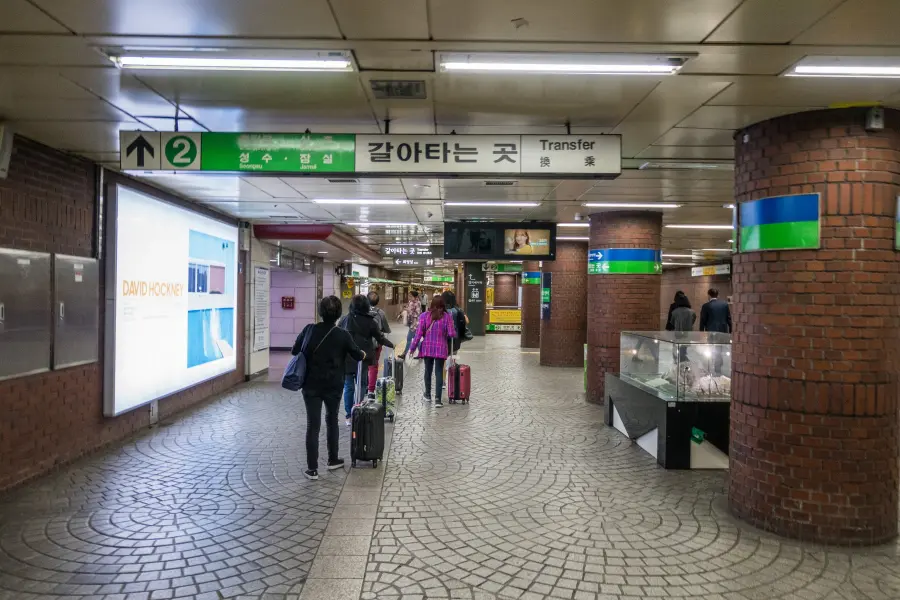
Check the signs carefully to find the right exit, as each station often has several directions to exit.
The Seoul metro is not entirely underground since some lines are similar to the Parisian RER. You can also reach incheon airport via the latter with AREX (the express train dedicated to the airport).
- Direct Express :~45 min · 2,500 (~€7,7) · luggage space.
- All-Stop : ~50–60 min · ~½ price, multiple stops.
- Frequencies Express: ~every 30–45 min; All-Stop: ~5–15 min First/last : approx. 5:30am–~23:50pm (depending on direction).
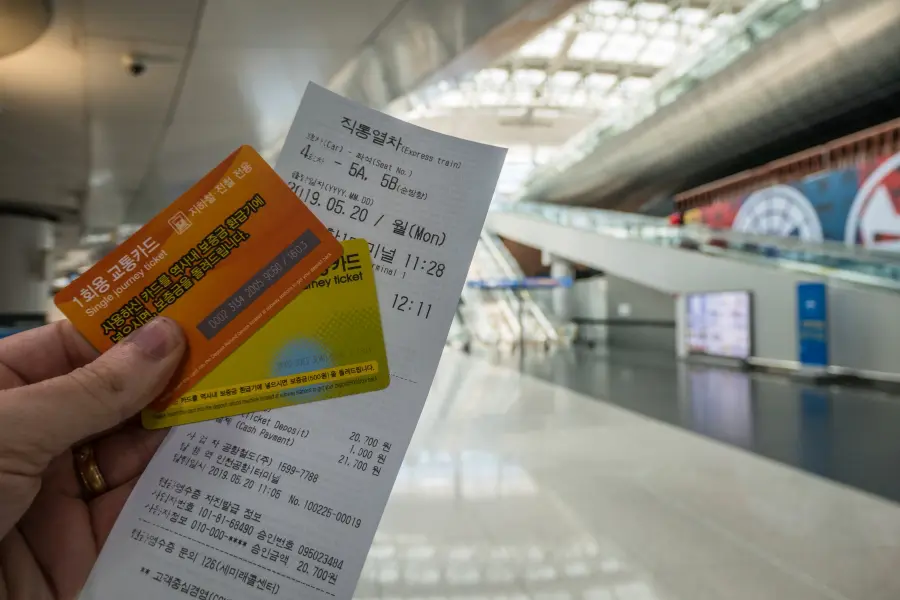
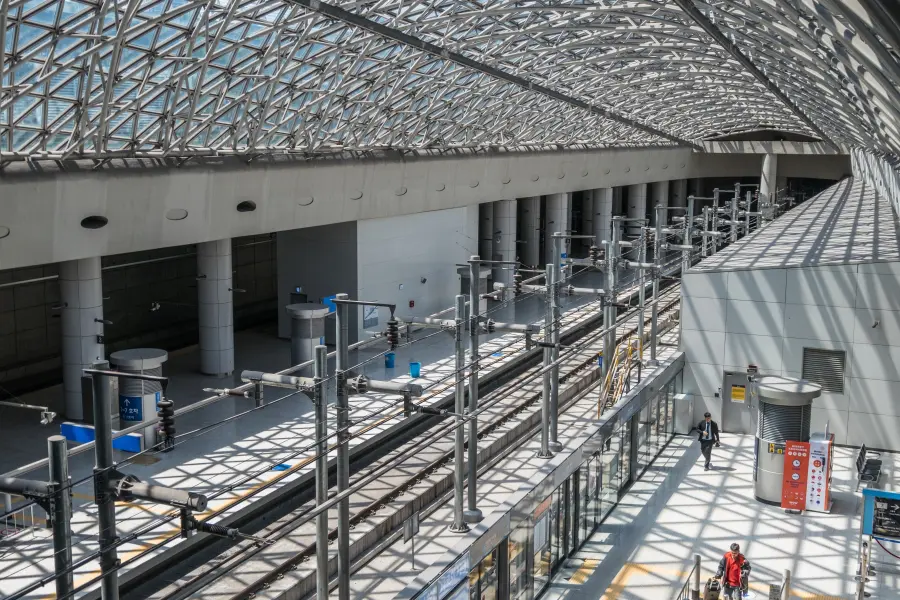

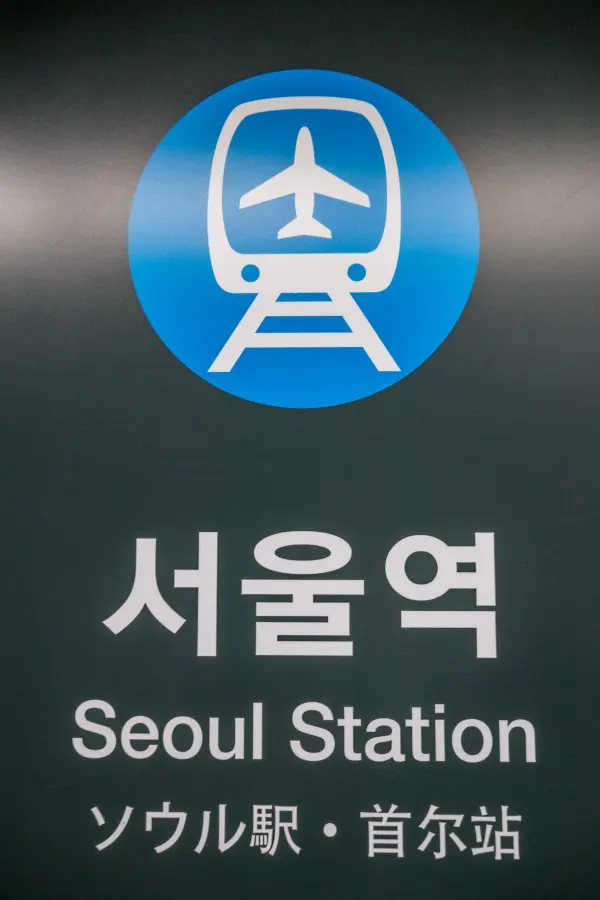
Shipping
As Korea is a peninsula, it is surrounded by the sea, and therefore it is only natural that it has a network of seaports and ferry connections.
It is possible to connect Korea with China, Japan or even Russia for international connections but I will not particularly develop this part here, you will find all the information on the tourist office website: International Ferries in Korea.
- Especially useful for Jeju and some islands (East/South coast). Flights are weather-sensitive (winds/typhoons): have a backup plan by plane.

Jeju-do (main connections & operators)
- Wando ⇄ Jeju : 1:20pm (Blue Narae) to 2:30pm (others) — Hanil Express company. Fare reference: ~€ 35 simple AR (variable).
- Mokpo ⇄ Jeju : ~4–5h+ (frequent).
- Yeosu ⇄ Jeju : ~5–6h.
- Busan ⇄ Jeju : ~12h (very long, not very practical).
Operators/information : Seaworld Express Ferry · Hanil Express The problem is that Korean websites don't have a good grasp of English; in this case, one solution is an aggregator like DirectFerries.
Advantages: scenery, possibility ofembark a vehicle (road trip) and to see other islands (e.g. Chuja).
Ulleung-do & Dokdo (East Coast)
- Pohang ⇄ Ulleung : ~3–3:30 (fast).
- Mukho (Donghae) / Gangneung ⇄ Ulleung : ~2:40–3:30.
- Ulleung ⇄ Dokdo : ~1–1:30 (weather is a determining factor).
Boarding formalities & advice
- Identity required : passport or residence permit even for domestic travel to the islands.
- Margin : vehicle → +1–2h pedestrians → +40 minTicket office closed.10 min before departure (even if booked online).
- Cancellations : check the state of the sea J-1/J-0Bring seasickness medication and a warm layer.
Air transport
There are 8 international airports in South Korea, which can serve as a drop-off point in the country, with a total of 15 public airports spread throughout the country.
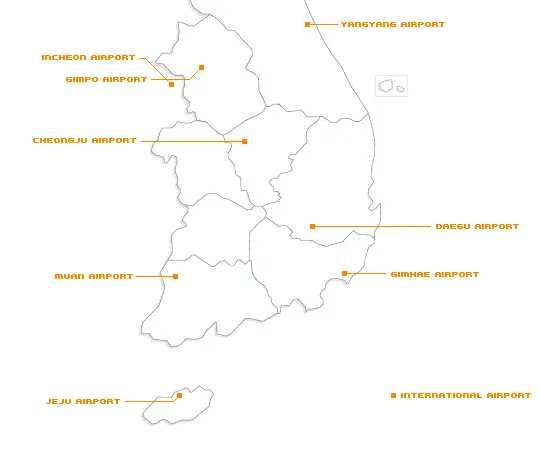
Korean companies (useful overview)
- Korean Air (domestic & international network).
- Asiana Airlines (domestic & international network).
- Jeju Air (LCC, Jeju base): domestic + NE/SE Asia, Guam, Saipan…
- Air Busan (LCC, Asiana subsidiary, based in Busan): domestic + China/Japan/SE Asia.
- T'way Air (LCC): domestic + Japan/China/SE Asia, Guam/Saipan.
- Jin Air (LCC, Korean Air subsidiary): domestic + Southeast Asia, up to Hawaii.
- Air Seoul (LCC, Asiana subsidiary): departures Seoul/Jeju to Asia (VN, KH, PH…).
- Fly Gangwon (regional): Yangyang base; flights to Gimpo/Jeju.
- Hi Air (regional, ATR-72): serves Ulsan, Yeosu, etc. (scalable network).
Checked baggage often optional on LCC; check the cabin dimensions.
Examples of durations & price ranges
- Gimpo (GMP) ⇄ Jeju (CJU) :~1:10pm · ~3,800–4,800 (depending on season/anticipation).
- Gimpo (GMP) ⇄ Busan (PUS) :~1h · ~3,800–4,800.
- Busan (PUS) ⇄ Jeju (CJU) :~1h · ~3,800–4,800.
- Promo marker : AR Busan ⇄ Jeju sometimes from ~€ 34 (cabin baggage).
Tips : prioritize morning flights (smaller delays); check terminals if train connection; compensate for CO₂ if possible.
Major international airports
In order of importance (in terms of traffic):
- Seoul (Incheon International Airport – ICN)
- Jeju Island (Jeju International Airport – CJU)
- Seoul (Gimpo International Airport – GMP)
- Busan (Gimhae International Airport – PUS)
- Daegu (Daegu International Airport – TAE)
- Cheongju (Cheongju International Airport – CJJ)
- Muan (Muan International Airport – MWX)
- Yangyang (Yangyang International Airport – YNY)
Domestic Airports & Useful Hubs
- Gwanju (Gwanju Airport – KWJ) — main airport in the southwest of the country
- Yeosu (Yeosu Airport – RSU) — port city in the south of the country
- Ulsan (Ulsan Airport – USN) — coastal city between Gyeongju and Busan, on the east coast
- Gunsan (Gunsan Airport – KUV) — small airport on the west coast, also used as a base by the US Air Force
- Sacheon (Sacheon Airport – HIN) — in the middle of the southern coast, it also serves the city of Jinju
- Pohang (Pohang Airport – KPO) — main port on the east coast, north of Gyeongju
- Wonju (Wonju Airport – WJU) — city in the heart of northern Korea, southeast of Seoul
With nearly 17 million visitors South Korea boasts a respectable number of visitors each year. While not as crowded as Japan or Thailand, the country attracts a significant number of Asian travelers: Chinese and Japanese alone account for more than half of all arrivals. Europeans, by comparison, remain relatively few in number (a surprising fact given the country's popularity on social media).
Korea also has some options of its own:
- Jjimjilbangs Korean saunas open 24/24 where you can spend the night for next to nothing (< €10). Local atmosphere guaranteed.
- Goshiwon : very simple (and very small) mini-studios, designed more for longer stays.
Jjimjilbangs: sleeping in a Korean sauna
On jjimjilbangs These are traditional public baths, open 24 hours a day, where you can also spend the night. It's a rather unique experience: relaxation, dry heat, hot baths (separate for men and women), and a large communal room for sleeping.
- Price : in general €7–12 according to the establishment.
- Comfort : heated floor, thin blanket, very local atmosphere.
- To know : we sleep “Korean style”, on the floor, in a non-private space.
To learn more, you can consult the detailed user reviews on the Korean Dream blog.
Long-stay option: Goshiwon & alternatives
Un Goshiwon It's a micro-room, often between 6 and 10 m², sometimes with a kitchenette. Ideal if you're staying for several weeks and looking for ultra-budget accommodation.
- Price : 150–350 € / month depending on the neighborhood/comfort level.
- Benefits : unbeatable price, autonomy.
- Drawbacks : small space, bathrooms sometimes shared.
As for accommodation, you'll find everything from budget options to a nice selection of modern hotels in major cities. Here are the most common options in Korea, in order of price:
- Guesthouses & hostels : dormitories or small single rooms €20–40 / night.
- 2-3 star hotels (city centers): modern rooms, good value for money €50–90.
- 4-5 star hotels : full services, often in business districts €100 and up .
The best hotel was the first one I tried in Seoul. I booked it thanks to my Agoda points (unfortunately no longer available), which allowed me to stay in a well-located 4-star hotel near the Euljiro 3(sam)ga or Myeongdong subway stations. Normally, a night's stay costs around €100, something I wouldn't normally afford (see sidebar below).
The rest of our hotels were much simpler. The second hotel we tried upon returning to Seoul, the Star Hostel InsadongIt was a somewhat self-contained hotel, in the sense that, apart from the cat waiting for us at reception (true story), there was nobody else around (although we did happen to bump into the owner, who is very attentive to his guests). The room was small but perfectly adequate. We were close to a metro station and in a really nice, lively neighborhood.
Another good place was the K-GUESTHOUSE Haeundae 1 in Busan, on a street less than 500m from Haeundae beach.
Which neighborhood should I choose in Seoul?
Seoul is huge and sprawling, but some neighborhoods work particularly well for a first visit. Here's a clear overview to help you choose:
- Myeongdong — Central, lively, perfect for a first trip. Direct access to lines 4 and 2, easy shopping, restaurants everywhere.
- Insadong / Jongno — Ideal for palaces, Bukchon, temples, Korean culture. Quieter in the evening.
- hongdae — young, creative, bars, cafes and street food. Convenient from the airport via AREX (no transfer).
- Itaewon — Cosmopolitan, full of international restaurants. More pronounced nightlife.
- Gangnam — Modern hotels, main thoroughfares, museums, chic cafes. More corporate, but very well connected.
Practical guide For a short stay (3–5 days), I recommend staying north of the river (Jongno, Myeongdong, Hongdae). You'll be closer to the essentials.
G2 Hotel Myeongdong
Note: 8,7 / 10
Budget: from €100
Despite the hotel's high standard, the room was still relatively small. However, the location was excellent and everything was spotless, with a comfortable bed and a well-insulated window (a rare find in Thailand).
To book a hotel in South Korea, please use the search tool:
Local currency : the official currency is the South Korean won (KRW) or its acronym, transcribed as follows ( )The following banknotes and coins are currently in circulation in South Korea:
- Parts : 10, 50, 100, 500
- Tickets : 1,000, 5,000, 10,000, 50,000
The rate varies, but generally:
- 1 € ≈ 1,600–1,700
- 10,000 ≈ 6–7 €
Conversion reference: To give a "rough" idea of the price, divide the first two figures by two.
Quick example – 50,000 → 50/2 ≈ €25 (actually a little over €30, so to get closer, add ~20%)
Daily : card / contactless payments are very easy, but keep some cash for markets, small restaurants and local transport.
Price benchmarks
Accommodation
- Entry-level bedroom: 3,800–4,800 (≈ €35–60)
- Standard hotel: 3,800–4,800 (≈ €70–120)
- Good hotel (Seoul / Busan): 3,800–4,800 (≈ €120–200)
Catering
- Small local restaurant: 3,800–4,800 (≈ €4–6; ~€5–7 with +20%)
- Coffee / drink: 3,800–4,800 (≈ €2–3,5)
- Classic restaurant: 3,800–4,800 (≈ €7,5–12,5; ~€9–15 with +20%)
- Higher-end output: 30,000+ (≈ €15+; ~€18+ with +20%)
Transport
- Metro (Seoul): 3,800–4,800 (≈ €0,7–0,8; ~€0,85–0,95 with +20%)
- City bus: 3,800–4,800 (≈ €0,6–0,75)
- Taxi (pick-up): 2,500 (≈ €2,4; ~€3 with +20%) + counter
Visits
- Temples / museums: 3,800–4,800 (≈ €1,5–5)
- Observatories / cable cars: 10,000–20,000+ (≈ 5–10 €+)
- Seoraksan cable car: 16,000 round trip (≈ €8; ~€9,5–10 with +20%)
For data updated by city (rent, restaurants, groceries…), check out Numbeo, e.g. for Seoul or, Busan.
Small budget
Average budget
Comfortable
Generally safe and well-equipped medically, South Korea does not pose any particular difficulties if one remains vigilant: dedicated insurance (always recommended), up-to-date basic vaccinations, air quality in spring, and weather in summer (typhoons).
Here is the essential information you need to know before going to South Korea.
Travel insurance — is it really necessary?
In itself, you can travel without it, but health/assistance insurance is strongly recommended: in case of hospitalization or repatriation, costs quickly add up and bank cards provide little coverage (low limits, short duration, civil liability rarely included).
This should also be taken into account if you are going to Asia for several months; this reinforces the importance of dedicated coverage.
I recommend you Heymondo Travel Insurance (5% discount via my link).
Transparency: if you subscribe via this link, I will receive a small commission — at no extra cost to you.
Vaccines & Health
No vaccinations are mandatory for European citizens. As always: DTP (adults) and MMR (children) vaccinations should be up to date. Depending on your schedule and profile, your doctor may recommend:
- Hepatitis A (frequently recommended)
- Hepatitis B (repeated/long stays)
- Typhoid fever (roots food, rural areas)
- Japanese encephalitis (extended rural stays in summer/autumn)
Malaria No systematic treatment. A risk to P. vivax exists in some rural areas near the DMZ (north of Gyeonggi and Gangwon): ask for advice depending on your route.
Air quality,
In spring, "yellow winds" can pollute the air (dust/particles from China). Adjust your activities on days when these winds are unfavorable (indoors, museums), and use a filter mask if you are sensitive to them.
Hygiene in South Korea
- Drinking water in the city; if in doubt, bottled water.
- Cook meat/fish thoroughly if you have a sensitive stomach.
Security in South Korea
South Korea is generally very safe, with low crime; you just need to remain vigilant as you would anywhere in tourist areas.
Pay close attention to the weather forecast (typhoons, heavy rain), and to the regulations surrounding the DMZ, where access is strictly enforced and visits are only permitted on organized tours (passport required). Keep emergency numbers and useful contacts readily available (see below).
Natural hazards: typhoons, rain and earthquakes
- Typhoons (July–September) : especially in the South and on Jeju: rain/winds, ferries and flights sometimes disrupted.
- Heavy rains : terrain = possible landslides or local flooding (some hikes may close).
- Earthquakes : moderate activity, especially in the Southeast: follow the evacuation instructions for public places.
Emergency numbers & useful contacts
- Police : 112
- Firefighters / Ambulance : 119
- Emergency Ready App (NEMA): information on risks/alerts, first aid procedures, useful in English.
- Volunteer interpreter service : 1588-5644 (one-time assistance with procedures/calls).
- Seoul St. Mary's Hospital (Seocho-gu) – International Medical Center: (02) 2258-5745 / 5746 (French-speaking contact indicated).
French Embassy in the Republic of Korea
43-12, Seosomun-ro, Seodaemun-gu
03741 Seoul
Tel: (+82) 2 3149 4300
Emergency number during the week: (+82) 2 3149 4405
Embassy website: https://kr.ambafrance.org/



